
I’ll admit that I was never super interested in ancient history; I think my last whack at it was in the early years of high school. Egyptians, Romans, Greeks? They were bygones to me – more mythology than history in my hazy lazy memory. What had always interested me more was modern times — 19th and 20th century. To me, these were the events that formed our modern world, and I have usually sought out museums and experiences that feed into this silo of interest.
But during a planned group dive trip with a bunch of the buds to the Red Sea, with an option to add on a week touring in Egypt, I found that I really started to groove on the ancient, and became increasingly fascinated with the incredible architecture (how the heck did they do that?!), and pictorial language. Hieroglyphics tell the story of who the ancient Egyptians were, what they believed in, and how a civilization of people lived thousands of years ago.
This trip was originally planned for Oct 2021, but we all know how that went. Or didn’t. We were fortunate that the Nile river cruise and the Red Sea live aboard dive boat that we had reserved and made deposits to were very gracious in pushing our trip almost a year forward. Added bonus: they were still in business after the pandemic. A lot of travel businesses did not make it. Very tough times for so many people. It did mean that we would be in Egypt in late August into early September. And it was fooking hot, up over 100F or 40C on some days. But that’s normal there for that time of year. And on the plus side, not nearly as many tourists cramming the sweaty venues ;^)
It was to be a tight schedule, as we were trying to fit in as many of the more notable sites and experiences in just a week, before heading to the Red Sea to dive. Cairo, Luxor and Aswan are all quite spread out — realistically requiring flights between them if not going by Nile river cruise for part of the journey. Mr G and I added on a day in advance of the start of our group tour, to try to get our feet on the ground after the long flights to get there. I would suggest to really do it right, 10 days to 2 weeks touring would allow a bit more breathing room to really explore Egypt and its many attractions — with more time to add on if going to Petra in Jordan, which is a natural extension if you’re already making the long travel to that part of the world.
In my opinion, Egypt would not be an easy place to get around without significant smoothing by local support on the ground. I’m sure it can done Lonely Planet style, but I am thinking that connecting the dots could create some logistical challenges for self-planners. And, honestly, the tourist-directed terrorism events of recent years would have made me nervous about trying to get around without a guide and some security (more on that later). In fact Mr G and I had avoided visiting this part of the world previous to this group trip, due to these random acts of violence and ongoing political unrest. And even though I am generally not a “tour” kind of traveler, I think it was the best approach in Egypt, at least for us.
Getting There
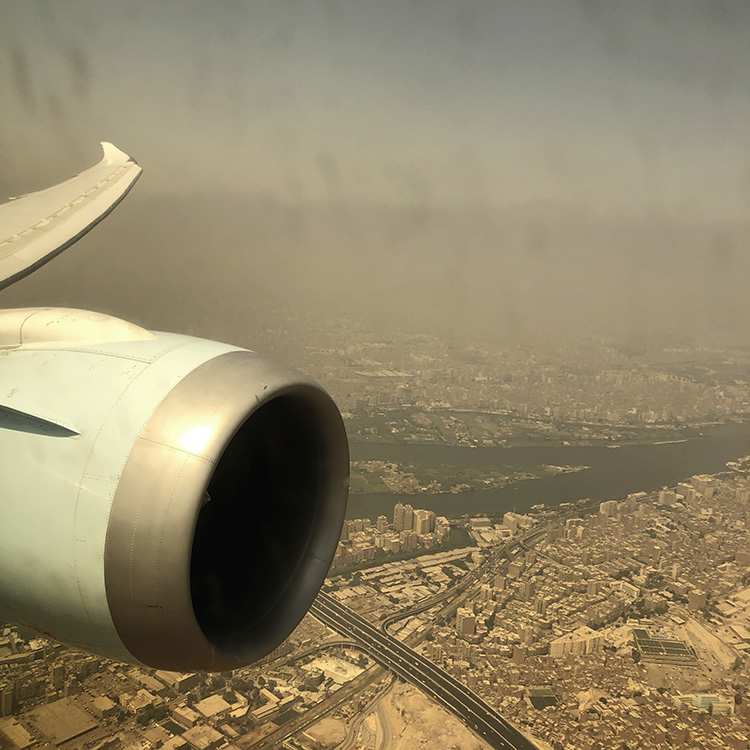
to sand particulate, blown in from the nearby desert.
Our trip started in Cairo —actually in Giza — which is a suburb of the massive sprawling city, and which is where the Giza pyramids — the most famous — are located. Our flights from Canada were pretty easy: Vancouver to Montreal, then Montreal to Cairo, all on Air Canada. Return flights took us from Cairo to London Heathrow on Egyptair, then Heathrow to Vancouver on Air Canada. Egyptair’s wide body aircraft was tatty and tired, and note: they do not serve booze on their flights.
You can and should pre-purchase your required Egyptian tourist visa online — recommended to do it at least a few weeks before departure. You can do it through Egypt’s E Visa portal: https://www.visa2egypt.gov.eg/eVisa. You’ll need to have your detailed itinerary at the ready as you are required to list all the places where you will be visiting/staying during your time in the country.
We were met at the airport by our congenial (and apparently chronically over-caffeinated ;^) Egyptian Greeter & Company Tour Facilitator, at the head of the chute off the plane, holding a sign with our names, before we had even hit Customs & Immigration! Our group dive travel agent is US based, and she contracted out a lot of the intra-Egypt moving parts to a local Egyptian tour company, which I think is the right call in a situation and country like this.
Our loquacious greeter whisked us through the formalities, then baggage pick up, and then poured our tired arses into a hired car with driver, who drove us through Cairo to Giza. It was approximately an hour’s eye-popping drive. You should expect it to take longer at peak traffic times. Also be prepared for local driving customs. Typically no seat belts. Tour buses doing U turns on multi-lane highways are a normal thing in Egypt — even on the fairly modern multi-lane highways running through the city. Horse/mule/donkey/ox/camel driven carts on major thoroughfares. People perilously picking their ways between onrushing vehicles across those multi-lane roads…
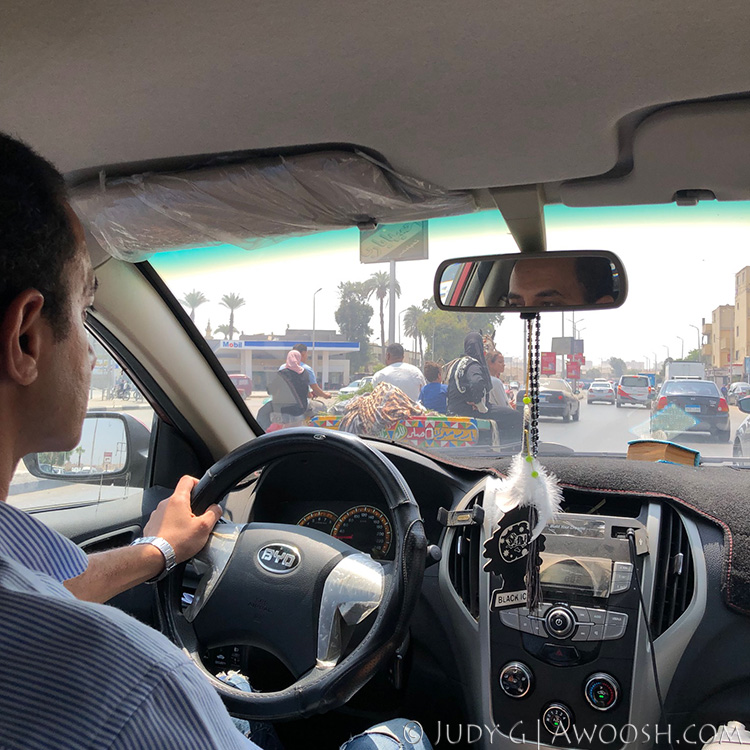
Along the way you’ll get a flyby view of Cairo’s sprawling (I mean huge!) necropolises – cities within the city — devoted entirely to the dead.
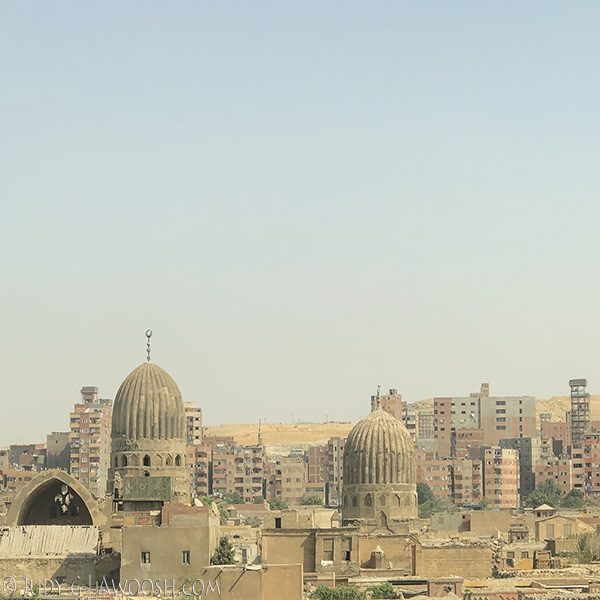
Private temples and family tombs, the whole enchilada.
You’ll also be craning your neck to look up at the Citadel — a large walled fortress perched on a hill above the city, with the ornate Mohammed Ali Mosque as its jewel in the crown.
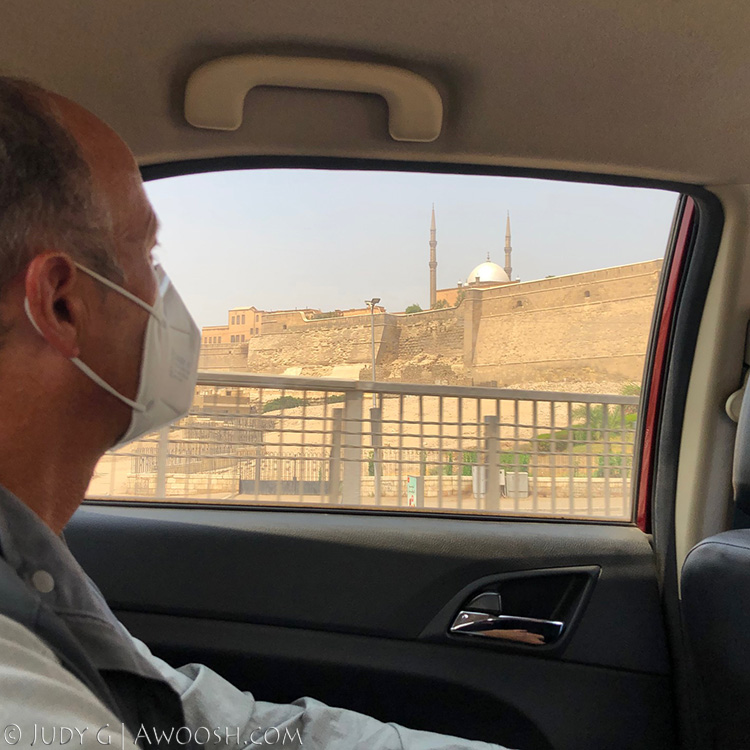
You’ll see many women dressed head to toe in black niqab tents (in 100F+ temps!), usually walking in pairs or groups, strolling along scorching hot sidewalks on their daily shopping rounds. You’ll cross the mighty Nile for the first time — the bringer of life and green and essential agriculture to Egypt — which otherwise appeared to me to be pretty much a sprawling craggy desert of a country.
You’ll see huge swaths of multi storey red brick square houses, almost always with quadrupled spires of rebar poking up from each of its four corners, waiting for another family apartment to be added on top for the next married son, and apparently deliberately wanting to appear unfinished so that the tax free status of homes under construction can be maintained, forever it seems. Cairo is a very crowded metropolis — current population pegged at about 22,000,000, but with many people apparently squatting in the aforementioned necropolises and in other derelict structures, that is probably not super accurate.
Cairo (Giza) Accommodation & Stuff
For the first three of nights of our trip we stayed at the Marriott Mena House, which is literally located in the shadow of the Great Pyramid – the biggest of the six that are visible in the Giza Pyramid/Sphinx complex.
It was pretty epic to walk out onto the balcony of our room on arrival and gawk at the massive stone structures — the first not more than a few hundred metres away! I also have to give a shout out to the beautiful pool at Mena House — really a lovely set up, and if you get there before the crowds in the morning, it’s a great place to swim laps.
In other intel, the bar (indoors) is very small and lightly manned. Alcohol consumption in Egypt is pretty much limited to partaking tourists. Devout Muslims, who are the significant majority of the population of Egypt, are teetotalers. We found alcohol to be readily available at the tourist hotels and restaurants that we visited. And I can vouch for Sakara Gold, which is a tasty Egyptian beer, and which was just the thing after a hot dusty day seeing the sights.
Mena House is a large hotel and has several dining options. Since we were there in (end era – I hope!) Covidtimes, we chose to eat outdoors — and their 139 Pavilion was perfect for this with its large terrace. This is also where they serve a pretty great breakfast buffet in the morning. Note: make sure to get breakfast included with your reservation if not leaving too early to enjoy it. There were some (tourist trappy) eateries outside the main gate, but we were happy to tuck in at the hotel for a couple of nights, and meet up with our other buds, who were trickling in from North America.
Must have: Mezze. This is like the Egyptian version of Spanish tapas. Trust me on this. Egyptian food is delicious, and we loved it. Much better to order local cuisine than try a gnarly Caesar salad, right Mikey? ;^)
After two years of postponed trips, it was so great to be able to see a gang of our dive buds again in person. A definition of good friends: folks that you haven’t seen for way too long, but when you do reconnect, it’s as if you were never parted and no time has passed. There were some heartfelt hugs, and tipping of glasses, and laughing about many funny shared experiences.
Security
As I mentioned above, there had been well-publicized attacks against tourists in Egypt in the late 1990s, all the way into late the 2010s, and around them many years of political unrest. For several years we chose not to go to Egypt, even though it would have been a pretty easy add on from Berlin (where Mr G had a part time office, and to which I came over a couple of times a year to join him for spouses-included happenings). Then a British colleague (who is a bit of an egyptology wonk) told us that we were being silly. He’d been going pretty much every year, even during the troubles, to see this wonder or that. He reminded us that the incidents were quite isolated, and in proportion to the volume of tourists who visit Egypt annually (masses apparently), statistically, it was quite safe to go.
Our first glimpse of added security after the airport was at the entrance to the hotel. They’ve got a gate guard there, who walks around the vehicle with a mirror on a long stick with which to have a glimpse underneath. The next screening was at the hotel reception – we were required to pass all our hand carried stuff through, and our luggage went through at some point as well. Did I think it might be a bit of security theatre there, and in other tourist locations where we were “screened” in Egypt? I’d say pretty much, but during screening at the hotel they did catch one of our dive bud’s dive knives that was packed away in his gear bag. They stored it for him till we checked out ;^)
On our first full day in Egypt, a small group of us who had arrived a day ahead of our planned group tour were picked up by two guys (and our guide Walaa, more about her later) in a small bus, to see some additional sights. The guy riding shotgun had what looked to be a sub machine gun, as well as a sidearm in a holster on his hip. We had an armed guy on board the buses for the rest of our land touring. It was a bit concerning for sure when we first noticed, but then we didn’t focus on it for any longer. It just was.
We felt relatively safe in Egypt — no doubt largely because we were in a managed pack. Like some other places I have visited in the world, women appear to still be very much under the thumb there. You really don’t see women walking alone or driving a car or a scooter. Modest dress is the norm, and we were advised to wear clothing appropriate to local custom. Not all women in Egypt wear the niqab (or variations on the theme) but almost all cover their hair with a hijab (scarf thingy) and wear skin covering clothing — loose fitting and comfortable. I packed a couple of long lightweight skirts, long sleeved sun blocking loose fitting shirts (which I layered over a cami top), and that worked great for me. Walking shoes, not sandals, if you’re going anywhere sandy (like the Pyramids complex), where the red hot sand will burn your tootsies. You’ll be taking your shoes off if you visit a mosque, so white sox are not such a great idea ;^). I wore a wide-brimmed sun hat too, to try to keep shaded from the big hot sun.
Day 1 — A Taste of Cairo: Necropolis — Coptic Churches — McGyptian Lunch — Citadel
I mentioned previously that some folks had decided to arrive in Egypt a day or two before the group gig began, and some of us ending up planning an added day of touring together. Our guide for our time in Cairo — Walaa — led the way. She was an animated, chatty and a deeply knowledgeable Egyptian university grad with a specialization in egyptology. Her command of english was admirable. She whisked us around the prescribed sites (in the small bus with a driver, and the guy riding shotgun), chatting as we went, sharing bits about life in Egypt and helping us make sense of some of the unusual things that we were seeing scrolling by our windows.
The plan for the day was to start in old, Coptic Cairo – an area of narrow, sometimes subterranean lanes. The oldest standing church (of its many) dates back to around 600-700 AD. This area is the Christian conclave of Cairo. In one of the two ancient churches that we visited, Walaa walked us through a cellar/crypt area where it is said that Mary & the young Jesus came to hide while Herod was on the hunt for them. This is apparently a special place to visit for devout Christians, and this whole Coptic area of Cairo is a very popular tourist mecca. We probably could have spent a day or two there digging in to the history, but hey, we had requested a sampler…
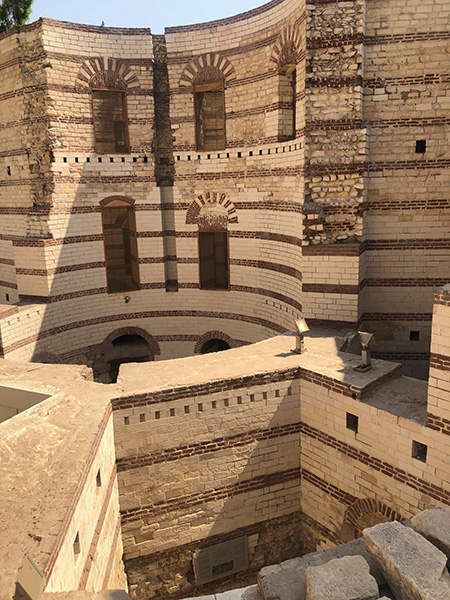
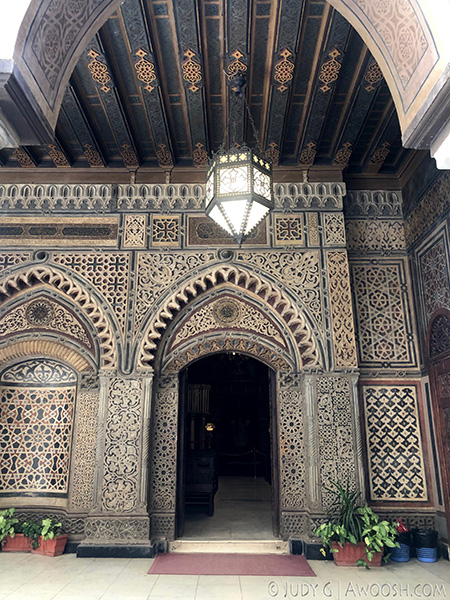
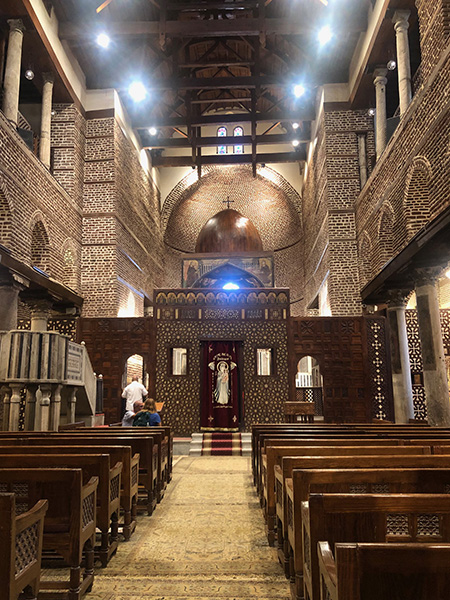
Egypt has a long and complicated history (and I hope I get the gist of it right!): Over the last ~5000 years Egypt has been invaded and taken over by many powers — including Nubians, Hyksos, Greeks, Romans, Mamluks, the Ottoman Empire, then the French and the British — both of whom vied for control of Egypt in a series of epic battles starting in the late 1700s — with the French invading in 1798 under Napoleon and defeating the soldiers of the Ottoman Empire in the Battle of the Pyramids. Right on the heels of that battle, the British (under Nelson) swooped in and defeated the French naval fleet in the Battle of the Nile, fought at sea. Napoleon retreated but many of the French soldiers left behind remained as a residual army to fight the Ottoman Empire. And out of this chaos, an Islamic leader – Muhammed Ali (he of the massive mosque at the Citadel in Cairo) came to power in the early 1800s.
Egypt was in a strategic location for the French and the British for the movement of resources and communications between the homeland and assets in India and other areas to the south. Once the Suez Canal was completed in the late 1800s, it was even more important to maintain control of it, which the British managed, via a tricky deal with Egypt (who needed bailing out financially after putting too much moolah into the project), to become majority shareholder, even though the French had been heavily invested in its construction. The Egyptians weren’t able to boot out the British completely until 1956.
At the core of Old Cairo are leafy streets rimmed with French and English colonial-style architectural reminders of the influence of these two cultures. We had lunch at a hopping spot — a multi storey Egyptian restaurant where you walk past the guys cooking the food on your way upstairs to a long table, one of many in the establishment, at a window looking out over a tree-lined street. Lunch was delicious — Kosheri — a traditional Egyptian comfort bowl of pasta, rice, lentils etc with a little jug of tomato sauce that you spice up and pour on yourself, then top with crispy onions. It was yummy to eat like an Egyptian.
Then it was on to the Citadel. I mentioned the lofty Citadel with its big towering mosque at the beginning of this thing — you get a view of it as you drive heading from Cairo towards Giza. It’s one of those stonewalled fortress kind of structures, at the top of a high hill near/in Cairo. It has been improved upon since early fortifications were built there, no doubt because of its excellent vantage point out over Cairo and outlying areas. Structure there has been documented back to the 1100s, but knowing more now about those smart ancients, it’s totally possible that there was something built on this strategic hill long before that, buried under what can be seen now.
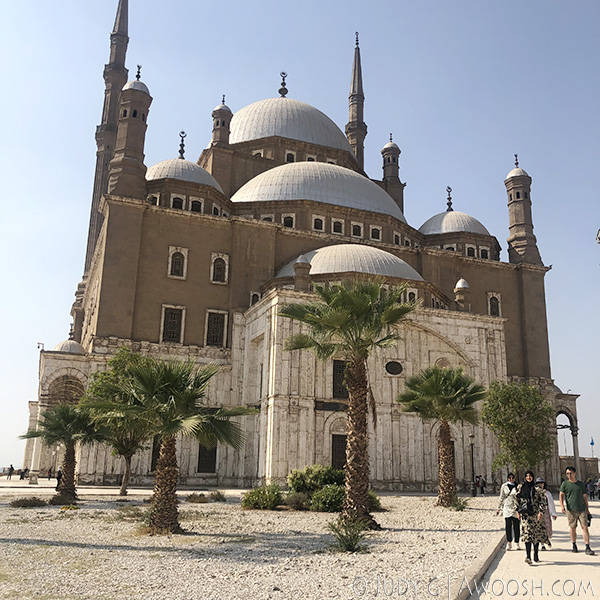
Again, we were on a quick awoosh kind of a tour, and the highlight for us at the Citadel was visiting the massive mosque — The Great Mosque of Muhammed Ali — which is not particularly ancient, being built in the 1830s. But it is impressive – and beautiful – and hearing the muezzin’s tonal calling to worship echoing off of those ornate surfaces while standing near the centre is something I won’t forget.

The file is too large so unfortunately I can’t upload it here.
Walaa gave us a bit of a primer on Islam while we stood in the great edifice, explaining some of the practices and the reasoning behind them, which was meaningful and interesting coming from an articulate believer. Everywhere in Egypt we heard the call to worship from the numerous mosques in every city and town. Muslims are called to worship five times a day — starting just before dawn and running into the evening. Minarets of the mosques, like church steeples in old towns, are elevated enough to be easily visible from most vantage points.
Day 2 — Giza Pyramids — Camel Ride — The Sphinx — Picture Vendor — Giza Gourmand Lunch — Egyptian Museum — Pyramids Light Show
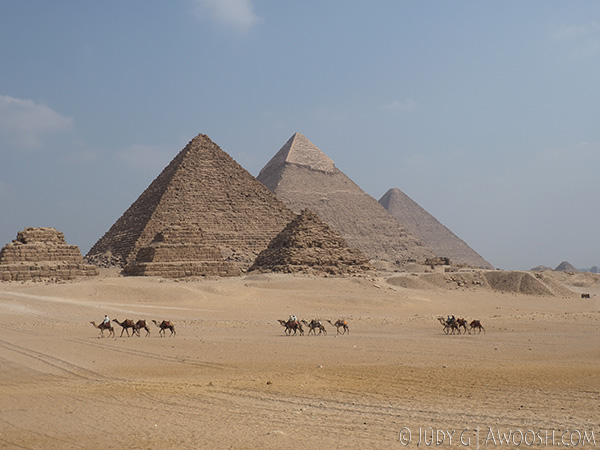
After a bite and a brew (or two) with the ever arriving circle of buds on the patio at Mena House, we tucked in for the night. The next day it was breakfast buffet at the hotel, and then we all (18 of us on this trip together) climbed onto a big white bus for the short hop to get into the pyramid complex. Walaa suggested that we should get a jump on the day as it promised to be smoking hot by late morning — and we were heading into the desert where it would bake even hotter with no chance of shade. The post pyramids plan was lunch and then a drive into Cairo to visit the Egyptian Museum (King Tut!) — planned that way so we’d be out of the sun for the worst of it.

his son Kahfre’s pyramid in the distance.
The pyramids are truly a breathtaking very big WOW! My photos and words cannot convey their ginormous size, nor the awe they inspire when in their presence. The oldest in the complex (Khufu – the Great Pyramid) is approx 450 feet (137 m) tall, and 750 feet (230 m) across the length of each side at the base. It is guesstimated to be dating back to 2550 BC. And there are even older, step pyramids in Egypt as well — the oldest documented as being almost 5000 years old.
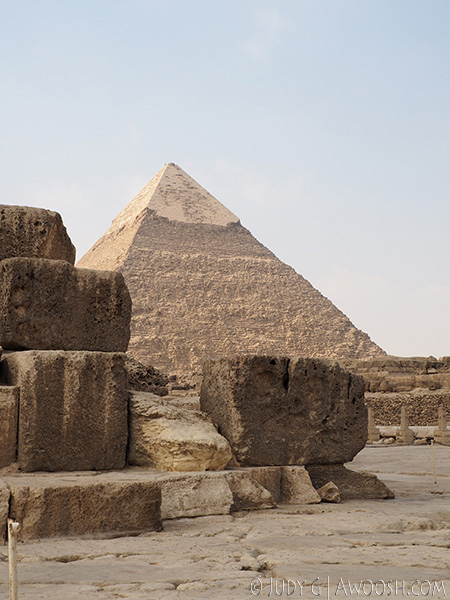
with remnants of the limestone facing visible near the top.
Each sandstone block is immense…
They make you feel very very small when you stand next to them — with their massive stone building blocks — each large pyramid made with over a couple of million of these huge, quarried stones. Originally each pyramid was faced with smooth polished limestone (effectively hiding the entrances to the tombs), and some historians suggest that they were crowned wth a gilded pyramidal triangle top, making them even taller, and awe inspiring, and highly visible from long distances away. Over the millennia the limestone that was used for facing them was removed and used for other purposes in Cairo and surroundings, but there are a few remnants on the pyramids that demonstrate what they would have looked like — glowing colossusses, with golden coronas, rising above the plain.

you can see puny humans climbing on the Great Pyramid.
An entrance into the tomb is visible in this shot.
From this perspective you can’t even see the top!
The current theory on how they were built: basically it is now believed that each row helped create a ramp up to the next level. But the weight of those huge stones — some locally quarried and some apparently quarried elsewhere and then floated to the area on a flooded Nile (and then somehow unbarged, and shlepped up, ever higher and higher), is mind boggling. As is the mathematical precision with which the pyramids were built — the four sides are perfectly oriented to the four cardinal points of the compass, and although the three large pyramids are not constructed in a straight line, they are in perfect alignment with celestial bodies above (the stars of Orion’s Belt).
Each pyramid was built (as the story went) in a matter of a few decades, not centuries. It was suggested to us that the current thinking is that unemployed farmers (not slaves), whose fields were inundated with the annual (pre-Aswan Dam) flooding of the Nile, supplied the bulk of the thousands of labourers it is presumed to have taken to get these things built. It was also suggested that they were a labour of devotion — that it was an honour to give one’s time and energy to their worldly god — the pharaoh who ruled Egypt at the time that each pyramid was built. Walaa explained that some fairly recent evidence suggests there were more permanent structures around the pyramid complex, that could have housed and fed full-time builders. The precision with which the stones were joined together, from rock hewn with only the soft metal tools that were available at that time in history, is truly incredible, and suggests very skilled labour was involved.
The pyramids at Giza were built as tombs for pharaohs — monuments to kings who were really considered divine, god-like figures in this land at that time. Each pyramid was commissioned while he was living, and so each watched the grand monument to himself being erected (Freud would have a field day with that ;^). The pharaohs (and other lesser Egyptians with resources) mummified dead people (and pets, and crocodiles!), and then parked them in a deeply located and usually hidden chamber full of fine things and supplies for the eternal afterlife, including drink and food. The ancient Egyptians believed that the burial chamber, once sealed, must never be disturbed, or the occupant would not progress on to the great hereafter.
Needless to say tomb raiding happened early and often, especially as the pyramids acted as huge beacons for robbers, and so the pillage began long before people from other parts of the world came to plunder, sell and/or export the artifacts. As a response to this, future pharaohs (and others) hid their tombs in less conspicuous places, as we learned when we got to the Valley of the Kings.
Honestly, it was a lot of info to take in, especially as I had been naughty and had done zero reading prior to the trip to give me at least a clue about it all. My bad.

A highlight of our pyramids visit was the chance to ride a camel out into the desert (US$50 + tip at time of writing, bring cash). It is only from this vantage point that one can see the three large pyramids, and the three (remaining) smaller pyramids which were apparently built for female relatives.
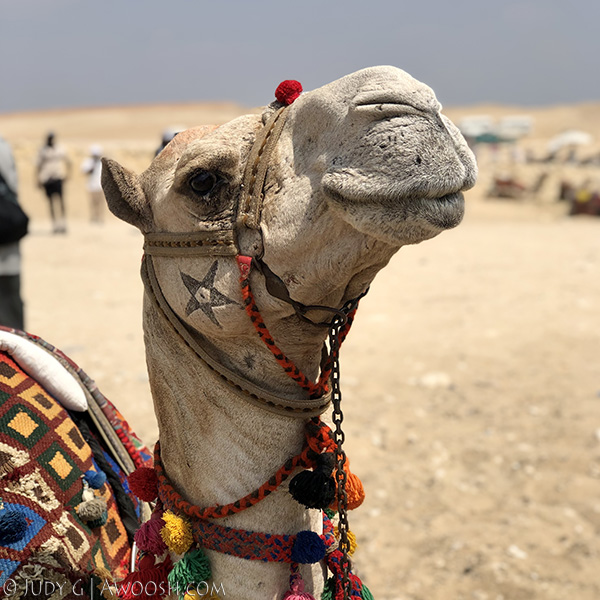
Camels are big and hairy and seriously comical looking critters. Like most mammals, they appear to have different temperaments, and can be quite vocal. It was an adventure climbing up into the saddle while the camel was obediently kneeling on the ground, and then hanging on while it galumphed itself up into a standing position. Our guide was a good guy who kept kind control of the camels and made us laugh, and the view from the desert, looking back at the pyramids, was very worth an uncomfortable ride on a very hot day. The only disappointment was the terrible amount of garbage littering the desert – mostly plastic water bottles. It’s really not that hard to pack out what you bring in people…
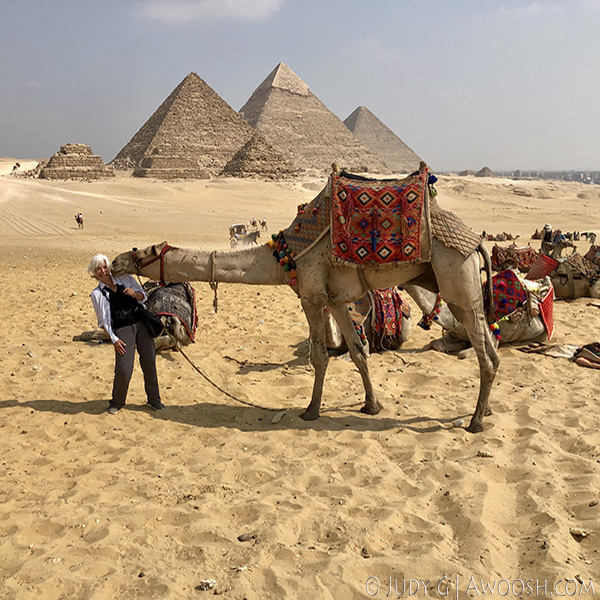
Photo cred: Mr G

horse drawn carriages are also an option to get out into the desert
for the epic view of the pyramids.

The Sphinx at the Giza complex is another wonder. Carved from a solid hunk of sandstone, it is massive, measuring over 70 metres (240 feet) long and 20 metres (66 feet) high. Again, my photos can not really show the scale of this thing.
Sphinxes were a big deal in ancient Egypt — typically heads of humans or other revered animals, and the bodies of lions/cats. Numerous sphinxes adorn important temple sites and causeways in Egypt, but the sphinx at Giza is the great grandaddy of them all. It is believed that it was carved out of the natural sandstone there, about 4500 years ago. Its human face (with the nose – it is said – blown off in or around the Battle of Giza between the French and the Mamaluke army in 1798). It is also said to be the likeness of Kahfre, for whom the second largest pyramid at Giza was built. Kahfre’s father was Khufu and his was the first, and largest ‘Great Pyramid’ to be constructed at Giza. Out of filial respect, Kahfre had his pyramid built slightly smaller in scale (but a little bit higher on the hill, so ultimately it looks like the tallest ;^), and he added the Sphinx and other significant structures to the pyramid complex during his time to make his indelible legacies and perhaps to (not so subtly?) outshine his dad.
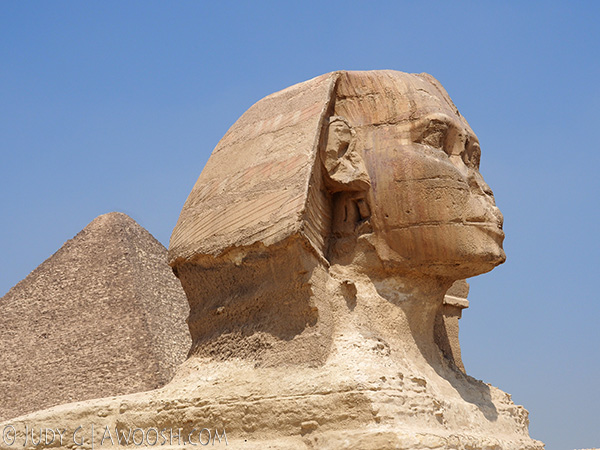
the builder of the second largest pyramid at Giza.
After an obligatory stop at a papyrus art shop/tourist trap in Giza, we got off the bus again and sat down to a massive Egyptian lunch at a restaurant nearby. We had hardly made a dent in the mounds of mezze delicacies before huge smoking patters of kebab appeared. We eventually rolled out of there, back into the big white bus, and headed towards downtown Cairo for our planned afternoon visit to the Egyptian Museum of Cairo. Our visit was in late August 2022. A new, very modern, Grand Egyptian Museum, in Giza, is slated to open sometime in 2023, and some of the antiquities from the old museum had already been transferred to this modern new location, which promises to be a huge — and hopefully climate controlled! — upgrade, making Giza even more attractive as a place to stay while visiting Cairo. Anyhoo, because of the in-transition status of the museum, we didn’t get to see all the stuff, but what we saw was enough for me.

With the downtown museum slated for demolition after the new one opens, little to nothing looked to have been done to keep it in shape for quite a few years. It was dimly lit, musty and humid in da house, and many priceless ancient antiquities were displayed completely unprotected, such that visitors could actually lay their hands on some of the sculptures etc. The plentiful mummies were all under glass.

There was no evident climate control, except (iirc) in the King Tut exhibit. Signage was minimal, and where it occurred, it was mostly hard-to-read, faded, handwritten, time-yellowed little notes stuck somewhere nearby the item – probably original to the museum’s 1902 beginnings. It was good that Walaa knew her way around, showing us what was most notable and explaining why, through the headsets we used. In my post-lunch stupor, and with a bit of a sore back from the camel ride, I could barely take it all in and did not photograph much.
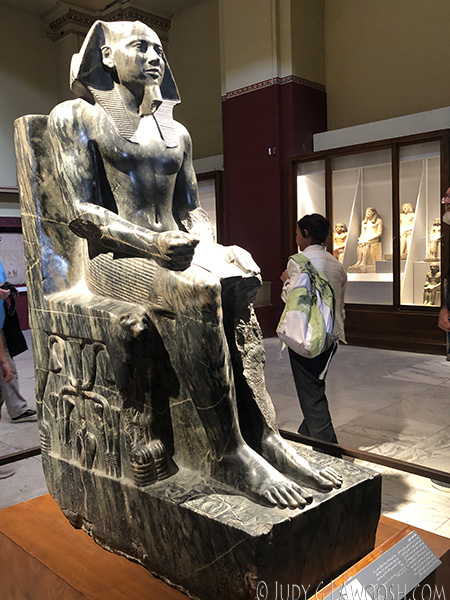
made with one solid block of diorite, a very hard stone.
This statue dates back to 2570 BC, making it over 4500 years old.
The highlight (and key attraction) of the Egyptian Museum is a special, guarded exhibit housing King Tut’s stuff. Although not considered a “major king” he is so famous because his ornate tomb was the last intact one to be discovered, in 1922. It was found in the Valley of the Kings (near Luxor) by a British expedition.
Tutankhamun came to power at a young age — just 9 years old — and he died young too – approximately 10 years later, around 1325 BC. DNA studies of his mummy suggest that malaria might have got him. They do know from X-rays that he also had an unhealed bone injury in his leg at the time of his death.
Minor pharaoh or not, his stuff is an amazing, opulent display (all behind glass) of three russian doll-like ornate sarcophaguses, which are somewhat like form-fitting coffins that Egyptian mummies were placed in. They were all beautifully carved, gilded and studded with precious stones, with the innermost being made of solid gold. His death mask is also a thing of beauty. Many other gold artifacts too (including gold sandals!). Alas, no photos allowed…
After the sweaty museum tour, it was back to Mena House for a quick bite and a beer, and then a bus ride back to the Pyramids/Sphinx for the “Pyramid Light Show”. As a group we agreed that the show was pretty hokey, and the voiceover supplied in English to our hinky headphones sounded like an old newsreel circa WW I. It was the only thing we did on our Egypt tour that I wouldn’t recommend…
We tucked in early for one more night, then at dark’o’thirty we headed to the airport for our flight to Luxor.
Day 3 — Valley of The Kings — Hatshepsut Temple — Luxor Temple

We were definitely on a roll. After the early flight from Cairo (which is about an hour’s flight to the north) we arrived in Luxor, were met by Nadar (our guide for this short Luxor chapter of our trip, and who herded us kittens with yalla, yalla habibi – loosely translated: let’s go dear people), and then we headed for the hills. The Valley of the Kings is across the river from Luxor, on the west side of the Nile (“East is for living, West is for dying”, per ancient Egyptians). Again, my bad – I had done no reading before our trip and really knew next to nothing about this location and the amazing structures we were about to dive into.
After the pyramid era in Egypt (the pyramids at Giza are the largest, but not the last to be built), Egypt fell into decline and the government became decentralized, which ultimately left Egypt open to foreign invasion and rulers. Future generations of pharaohs wrested back control of Egypt, worked to reunify the country, and Luxor (Thebes in ancient times) became an important location for temples and tombs. Eventually, the pharaohs had turned away from building grand visible tombs (pyramids) and started to hide their tombs in the hills where it would seem less likely for them to be raided. Remember – it was essential to these ancient Egyptians that their tombs, especially the mummies that they contained, not be disturbed, or the occupant would not proceed on to eternal life. Its is believe that most of the burials of pharaohs in the Valley of the Kings happened between 1500 and 1000 BC.
The tombs in the Valley of the Kings are basically like mines – excavations/tunnels that run deep into and under limestone hills. These tunnels, once decorated, created long elegant approaches to the ornate tomb chambers buried deep within. The engineering that was required to build these, the precision with which they were constructed, and the beautiful decoration of almost every surface is staggering. Unfortunately, despite being discreetly hidden away, many of the tombs were raided at some point after they were closed up with their mummified occupant(s) within. This is why King Tut’s tomb is so famous – it was the only tomb so far to be discovered in modern times (by a British expedition in 1922) that had not been emptied of its treasures. And even more exciting — there are still tombs that are yet to be found!
After running a gauntlet of too aggressive vendors (which seem to populate all the major tourist sites in Egypt), we had a quick look at a scale model in the Visitor’s Centre, which showed all the tombs that have been discovered thus far. Then we jumped on the electric trams which transport tourists from the Visitor’s Centre to the area where the entranceways to the tombs are located.
Did I mention it was hot? Crazy hot – at least 40C (about 105F) that day. It was extremely important to drink lots of water in that kind of heat, and whenever possible, to get out of the sun.
The tombs themselves, being tunnels in the hills, were of course in shade, but they were very humid, no doubt because of all the sweaty humans trekking through them. Nadar explained that it is an ongoing battle to try to slow the degradation of the tombs caused by human visitation. Tombs are opened and closed to the public on a rotating schedule to try to slow the decay, and in some cases clear panels have been placed in front of some of the walls to stop people from touching them.
A ticket to enter the complex allows you to tour three tombs in one visit, with King Tut’s tomb being a possible extra cost add on. Our guide Nadar suggested the three that we visited (Merneptah, Ramesses III, and Ramesses I), as being beautiful examples for us to view. Our guide was not permitted to enter with us as having people bunched up around him in the narrow corridors would have created roadblocks for others, so he fairly quickly explained what the salient features were of each tomb we were about to visit, and then we would head in without him.
First up, KV8 – Merenptah’s tomb. Great grandson of Ramses I (whose tomb we will visit last in the Valley of the Kings). Merenptah reigned Egypt from 1213 to 1203 BC and was best known for his leadership in protecting Egypt from Libyan invasion. His father Rameses II was one of the longest reigning kings in ancient Egypt, and one with a several wives and a huge amount of progeny. Merenptah was his 13th son, and like the current reigning King Charles III in Britain, he had to wait a looooooong time to be king.


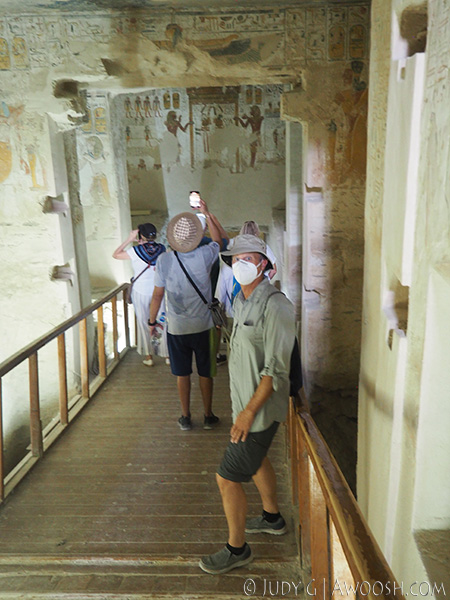


including the ceiling of his burial chamber, with its starry motif.
Next up, we visited KV 11 – Rameses III. He ruled from 1187 to 1155. A CAT scan of his mummy revealed a deep knife wound to the throat. It is believed he was murdered in a plot hatched by one of his wives to promote her son to be king.

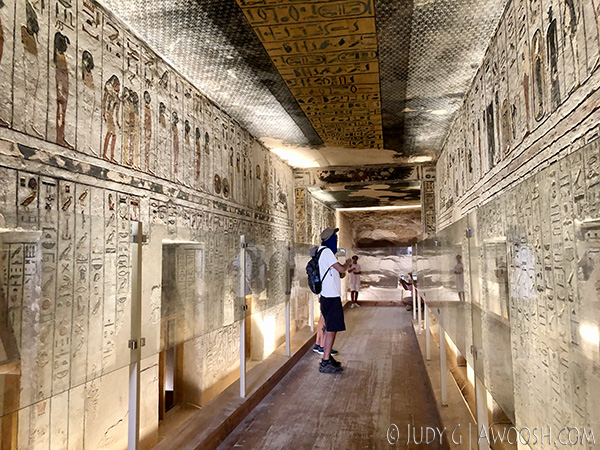
Some effort happening in this beautiful tomb to keep humans from touching/degrading the hieroglyphic & pictorial carvings. This tomb is also notable for the hard jog to the right, rather than a grand straight access to the burial chamber. This is believed to have happened because the workers excavating the tomb ran into another one, to the left, so had to change the plan mid-dig.
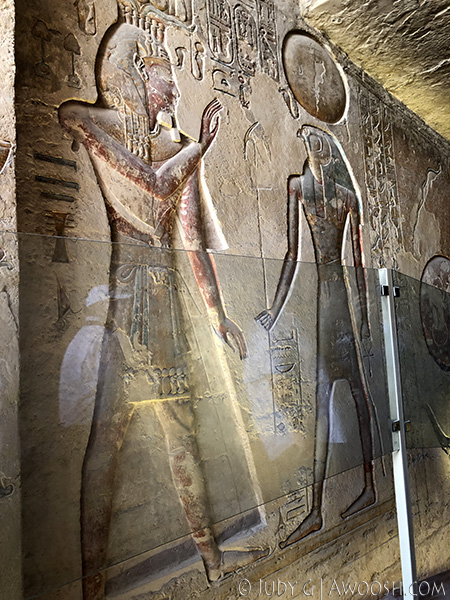
The final tomb we visited was KV 16 – Rameses I. This guy was not born a royal – Horemheb, his predecessor, had no sons of his own, and so he strategically chose Rameses I, a successful military leader, to succeed him. But Rameses I was quite an old man when he ascended, and only ruled for about 18 months before his death. For this reason, his tomb appears truncated and unfinished. The decorations on the wall were painted directly on plaster, when given a longer time to complete the project, they would have normally been done in carved relief. It also appears that his red granite tomb was placed in a smaller than normal funerary chamber (probably originally designed as an antechamber) and so it looks like they didn’t get the dig finished before he died. As the tomb would not have been started until he became king, it gives a good sense of what the ancients could accomplish in 18 months.
An interesting tidbit about Rameses I’s mummy – it had been removed from his tomb in antiquity, and then somehow found itself in Niagara, Canada in the mid 1800s! It then spent some time at the University of Georgia, before finally being returned to Egypt in 2003.
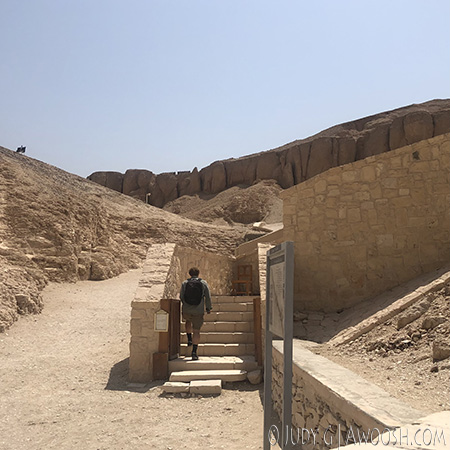
so I did not photograph the interior approach to the tomb.
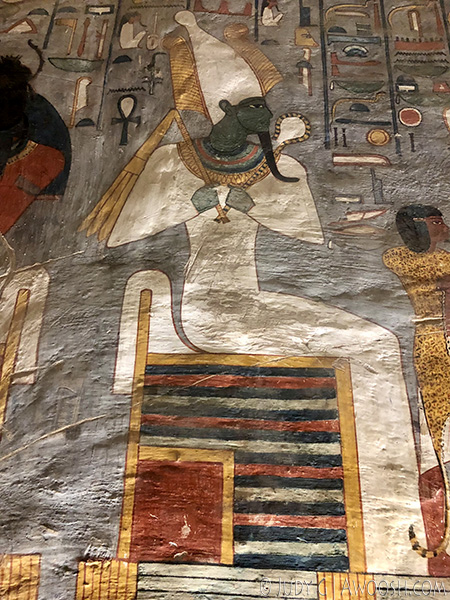
Lord of death & rebirth, amongst other things.
His face is always green.

than in the tombs we toured before this one, and there were large swaths
of undecorated surfaces, indicating that it was probably a rushed job.

meets Horus (bird head – god of kingship & the sky)
& Anubis (jackal head – god of the dead).
Mortuary Temple of Hatshepsut

Our next stop after the Valley of the Kings was the Mortuary Temple of Hatshepsut. She is an important figure in Egyptian history — the first known female pharaoh (apparently she promoted herself from the position of regent ruler for a minor male child, and claimed the right to rule as she was the previous king’s daughter). She was a notable leader too, and she ruled from 1479-1458 BC. After she died, it appears that there was quite a lot of effort made to erase any vestiges of her reign. Whether it was out of jealousy of her good stewardship of Egypt, or misogyny, no one really knows, but it took historians a long time to learn about her.
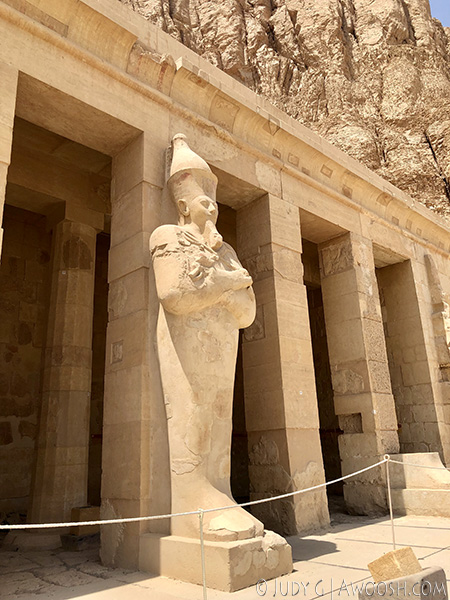

how the ancient Egyptians would have used mineral paints
to decorate their many temples and other important venues.
Near midday, it was as hot at hades at Hatshepsut’s temple, and we were already wilting from our time in the Valley of the Kings, so it was a fairly quick visit. Again, a tram takes visitors from a huge parking lot to the foot of the steps leading up into the temple.
There were very few visitors at this famous site when we visited. At the time I didn’t really question why – but having researched a bit for this trip report, I know now that this place was the site of a terrible massacre of international tourists — over 60 people were killed in the temple on November 17, 1997, by extremists who were apparently trying to force the release of/retaliate for the imprisonment of the mastermind of the early twin towers bombing in 1993. It is possible that some tours still avoid visiting the site because of this morbid history. I know I feel differently about walking through there with this hindsight — the dozens of victims were hunted within the temple and then gunned down or knifed to death. I would have stood where some had fallen and shed their blood as I wandered through, stopping to look at the beautiful decorations on the walls and ceiling. If there is any memorial signage on site about this terrible event, I did not see it.
After lunch at a rural eatery on the way back to Luxor, we stopped by an alabaster artisan’s shop/tourist trap where some of the group fired up their credit cards to buy various pieces carved from alabaster (which in Egypt is technically a type of calcite — calcium carbonate — that’s for any rock geeks reading this ;^). The Egyptian alabaster is beautiful translucent stone that can transmit light.
After checking in at the hotel, and a bit of welcome pool time (including a couple of frosty Sakara Gold beers ;^), we were picked up for the short drive to Luxor Temple. This was an evening visit, so tougher for photography.
Speaking of photography, other than the underwater photos near the end of this thing and some wildlife shots in Aswan, I mostly used my iPhone to take pictures while touring in Egypt. I have also greatly downsized my photos to help ease the download of this long pictorial trip report, so they may appear a bit grainy, especially on larger screens.
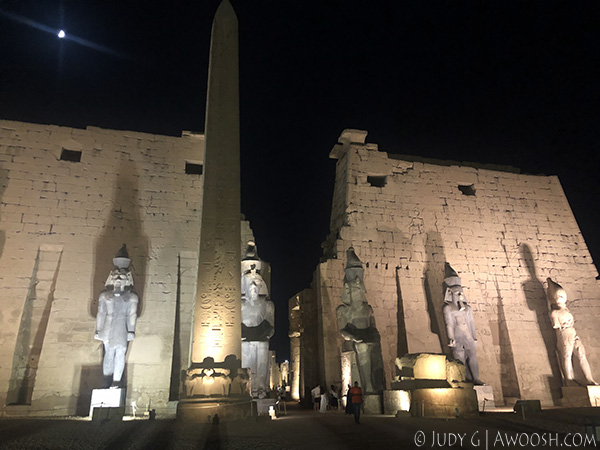
flanking the entrance, but the one on the right was destroyed, probably in an earthquake.
Like many structures we visited in Egypt, Luxor Temple was awe-inspiring. For me, it was all about the architecture. The massive scale of the columns — each quarried and carved from one piece of stone, then capped by huge, level architraves (stone beams that go from the top of one post to the next), which then supported massive slabs of hewn & decorated stone used for ceiling panels. Seriously, how did they do that? I asked our guide Nadar to please explain, but he said they really don’t know. One theory that was floated is that the ancients levelled the ground, and then formed the foundations (including structure to keep the flooding Nile out). Then they put in the huge blocks of stone that supported each pillar, perfectly spaced and linear in all directions, and perfectly even in height. Then they erected each quarried and carved pillar (brought in from elsewhere, up or down the Nile when it flooded enough that they could be delivered right to the edge of each temple). They popped each one up on top of its stone plinth — perfectly centred and spaced and linear in two directions. Exterior walls would be built up to support the roof as well. Then they would fill the (seriously huge) structure with sand (accomplished by thousands of workers?). Then they would be able to ramp up to the temporary top of the hill to place the heavy horizontal lintels across the tops of the posts. And then place the massive flat stone slabs that made up the roofing on top of them. And then they removed all the sand. And voila! ;^)
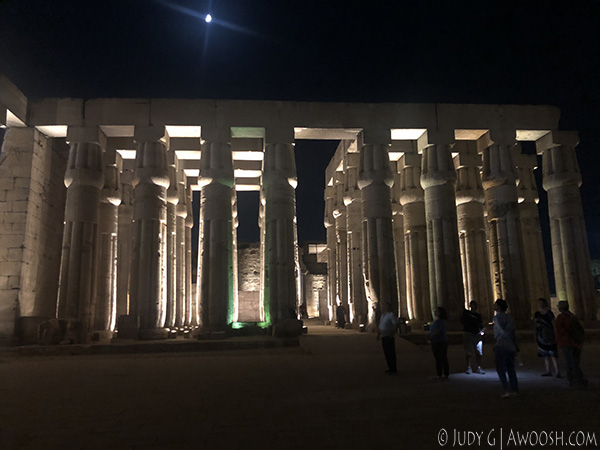
There are various chambers within the Luxor Temple complex, and Nadar explained that the oldest part of the temple would be at the back, furthest from the main entrance. Subsequent pharaohs would add on their legacy space to the temple, and then someone else would build in front of that, and so on. This was also true of Karnak, which is the largest temple complex in the world, and which we would visit the next day.

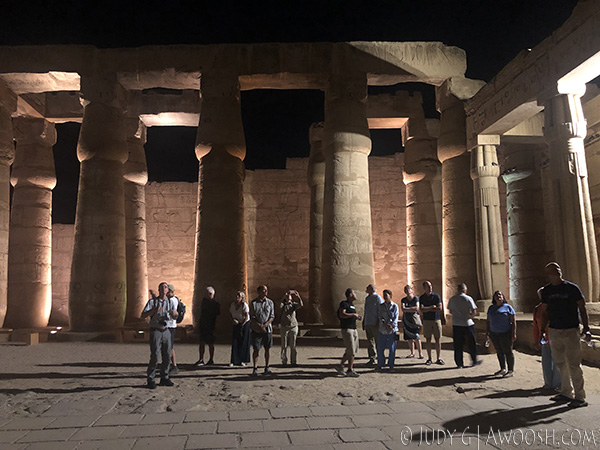
And then there is the “Avenue of Sphinxes” which stretches from Luxor Temple all the way to the Karnak temple complex, which is a few kilometres away. Apparently hundreds and hundreds of stone sphinxes, many quite damaged, line this road. Buried for centuries in sand (as were many ancient Egyptian sites), it was not rediscovered until the late 1940’s. Eureka!
I did not photograph the sphinx alley as it was dark out, but you’ll get the idea of the scale of the sculptures from a photo I took at Karnak the next morning, as they were very similar.
Day 4 — Karnak — Temple of Khnum — Esna Walk About — Noor El Nil Liveaboard Nile River Boat

Another hotel wake up, this time in Luxor. We had been offered the opportunity to go ballooning at dawn, which would provide an opportunity to see the Valley of the Kings (and nearby Valley of the Queens), the Nile valley, the Luxor Temple and Karnak temple complexes, and the general lay of the land, from above. I regret that I did not do this. It all just seemed a bit rushed over those early days of the trip, and we were still a bit jetlagged, and wilted from the heat, and the ambitious schedule. That add on just felt like too much. Bygones.
After breakfast we were picked up in a shuttle bus and driven to Karnak, which is a sprawling temple complex in Luxor, and at 200+ acres, it is the largest temple complex in the world. Again, with only a few hours to spend there, we just got a sampling of this extraordinary site. It was interesting to see that there appear to be numerous archeological excavations and restorations ongoing. Also noted was quite a lot of damage, some apparently the result of past earthquakes, which caused some monuments to topple. Like Luxor Temple, different Pharaohs (including the she-Pharaoh Hatshepsut) had added their own dedicated spaces to the the rambling, somewhat disorganized site.
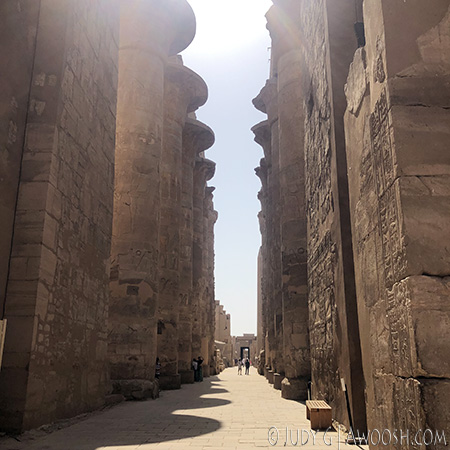
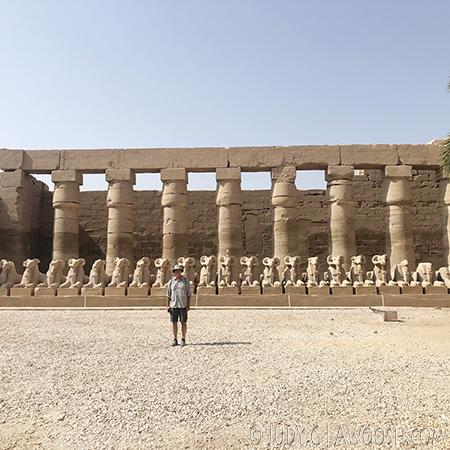
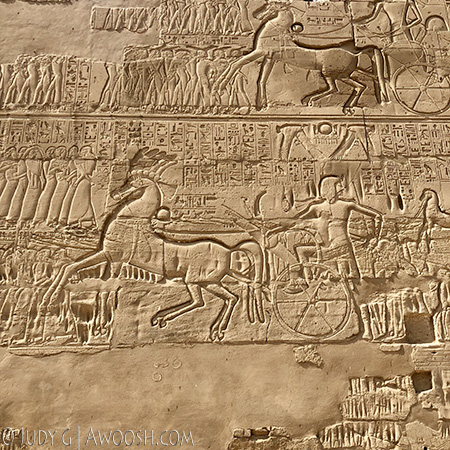
I thought it was interesting that this is believed to be the first depiction
of a horsedrawn chariot in ancient Egypt.
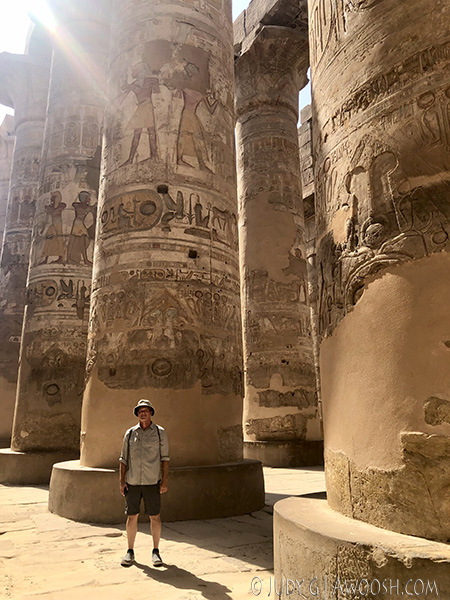
After the Karnak temple tour, it was back on da bus, and we drove for a few hours to Esna, a small city bordering the Nile. This is where we would board the Noor El Nil five night river cruise that would take us all the way up the river (southwards) to Aswan. Before boarding, we were offered a quick visit to see the Temple of Khnum — yet another ancient structure, this one with beautiful columns supporting its roof. This temple was started by the latter pharaohs, and finished during the Greco/Roman rule of Egypt, which happened from about 300 BC to 600 AD. The style of the columns was quite different than the columns we had seen in Luxor – quite a bit more ornate. Again, ongoing restoration was happening here as well.

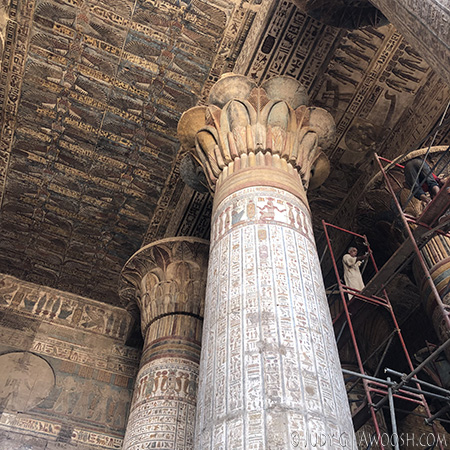
reveal the beautiful and complex decorative painting
and carving beneath. It is painstaking restoration that will take many years.

including carved graffiti from early foreign visitors!
We were also offered an opportunity to walk through the local market to check it out. Note to self: it is a great idea to carry a stash of US$1 bills (US currency and Euros seems to be accepted at all major tourist locations) while traveling in Egypt. We blew through a wad of these small bills tipping various people along the way – porters, drivers etc. It is also a good idea to get your hands on some Egyptian pounds on arrival from an ATM, so you have some currency that will work in the local markets, should you want to buy anything.

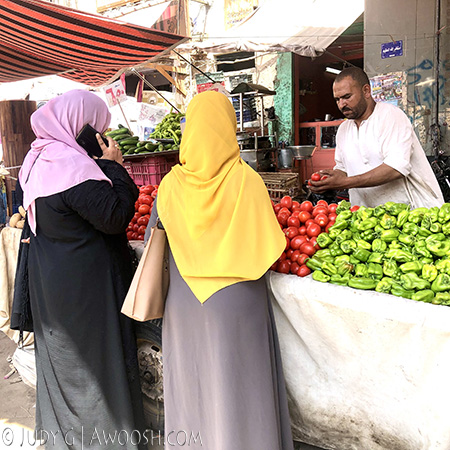


And then, at last, we boarded the boat! This part of the trip was definitely the highlight for me of our time in Egypt.

Our group loved Noor El Nil. This company has seven of these smaller, traditionally styled dahabiya boats in their fleet. Dahabiyas are essentially wooden, barge-like vessels, with a large sail fore and aft that can catch enough wind to push the vessel up river, despite the quite strong current running south to north in the Nile. Our group had chartered one of the boats on the lower end of the cost scale, but the company upgraded us to the Meroe (we were there in off season), which we found to be very comfortable, and as we were only 17 pax on the boat, we had lots of room to lounge around. The cabins were nicely appointed (and air conditioned), the beds were comfortable, the crew was helpful and attentive, and the food (all served at a long table on the top deck in the open air, under a huge shade canopy) was very good. Adel, our egyptology guide, was great. These boats got a mention in a recent Conde Nast story as one of the top ways to cruise in the world, and we could see why.
There is a huge flotilla of tourist boats churning up and down the Nile — some of them basically look like smaller scale cruise ships that can take hundreds of passengers. Most of them are large enough that they aren’t able to stop at some of the smaller, special sites that we toured on our way up to Aswan. Noor El Nil does leisurely, one way, five night/six day journeys from Esna to Aswan.
The pace of this part of our trip was perfect – usually a tour of some archeological site in the morning, before it got too hot, and then an afternoon lazing on board, often under sail, with a chance to swim in the Nile offered a couple of times during our trip. Every now and then a tug, which shadowed us the entire trip, would loop in to help out, especially to moor the boat along the banks of the river for visits to archeological sites, and in quieter places for overnight stays, where we would wake up to the sound of bird calls and watch the local farmers and fishers doing their thing.

The ever changing Nile is a visual feast, with its verdant banks and reedy islets rich with bird life (and a few water buffalo), and the craggy crumbling dessert hills beyond. We stopped at various historical sites, where Adel led us and helped us to make sense of what we were seeing. We also had the opportunity to visit a few small villages along the way, where we gained some insight into how people live in rural Egypt.
Day 5 — El Kab (Nobles’ Tombs) — Edfu Horus Temple

where we visited some nobles’ tombs.
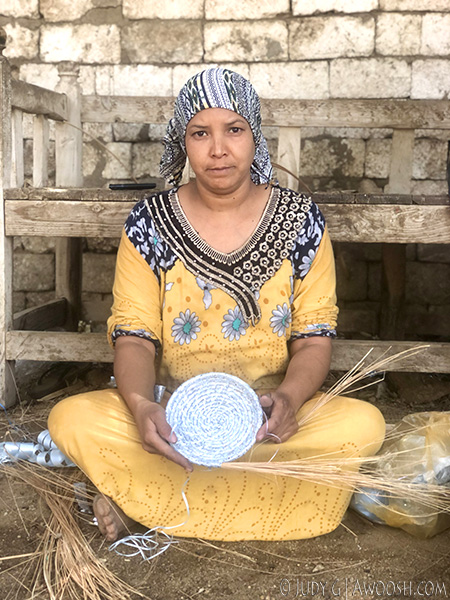
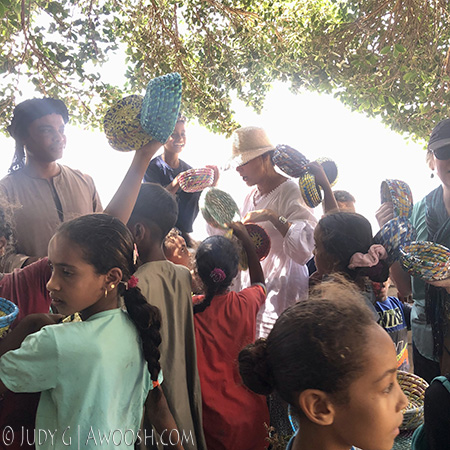
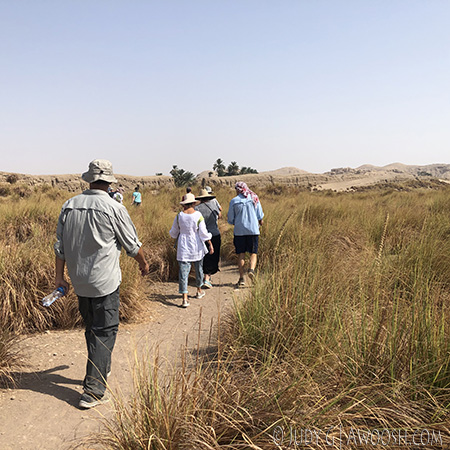
nobles’ temples, which are truly in the middle of nowheresville.
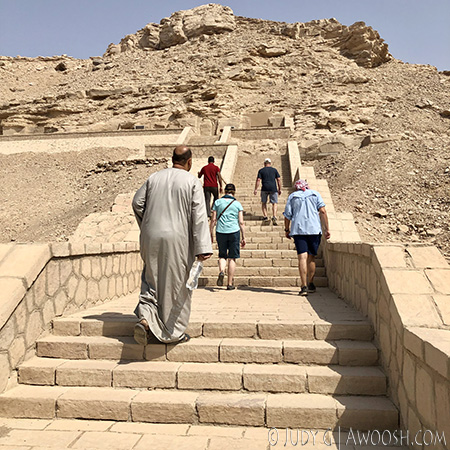
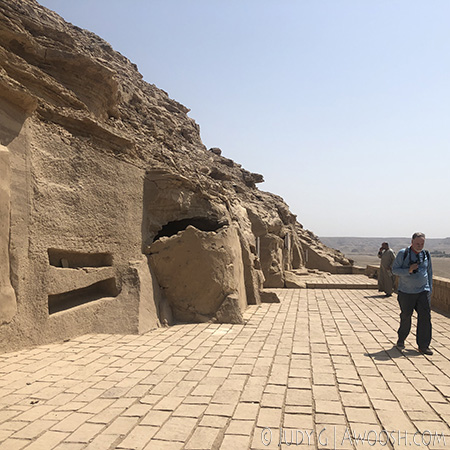
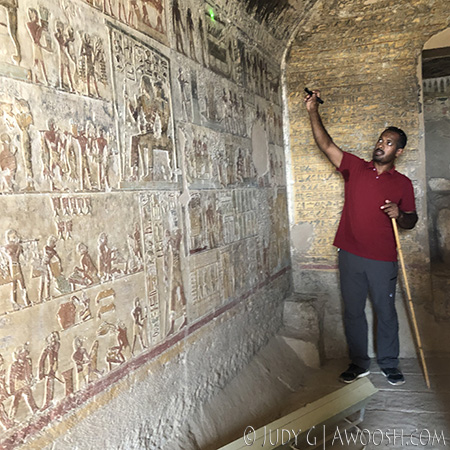
the heiroglyphics and images adorning the walls. In the king’s tombs we saw in Luxor,
the depictions and stories were more about the afterlife and the gods.
In the nobles’ tombs they were more about family and lifetime achievements.
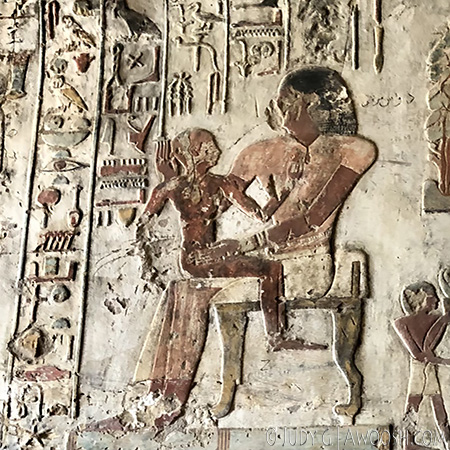
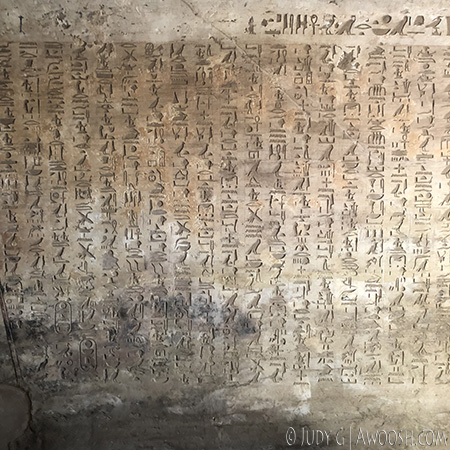
where master artisans would have been employed by the kings.
Back on the boat for lunch, a bit more cruising upriver, and then we were offloaded in the city of Edfu, in order to go and have a gander at The Temple of Horus. This was a lively excursion as we were transported in horse drawn buggies through town to get to the temple complex on the other side.
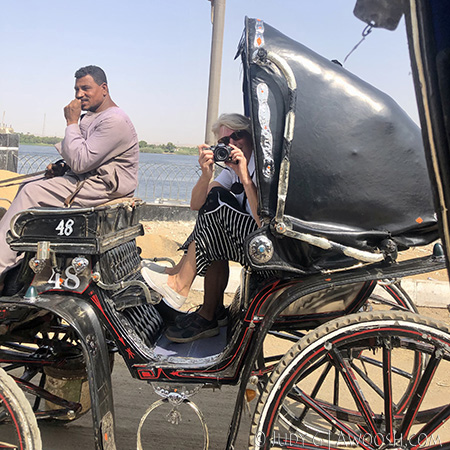

This temple was built during the times of Greek rule over Egypt (apparently over the ruins of an earlier Egyptian temple, also dedicated to Horus – a major ancient Egyptian deity, usually depicted as a falcon), The temple was constructed between 200 and 50 BC. These dates are known as there is a lot of information inscribed on the walls of the temple about its origins.
On this trip we toured several temples built during this Greek era – specifically the Temple of Khnum in Esna, this temple in Edfu, and Kom Ombo near Aswan at the end of our Nile boat trip. These temples differ from the more ancient temples at Luxor and Karnak – they are more organized, with architecture that lends itself more to ancient Greece than the earlier Egyptian construct of temple upon temple, built by a succession of kings.
Eventually these “pagan” temples were damaged and defaced by the Christians/Romans who took control of Egypt in the early centuries AD, and who were not tolerant of “the false gods” of polytheism, which was the faith structure of ancient Egyptians, Greeks and Romans. The story has it that this temple (and many other archeological wonders in this part of the world) in time became buried in desert sand, only to be re-discovered many many centuries later.
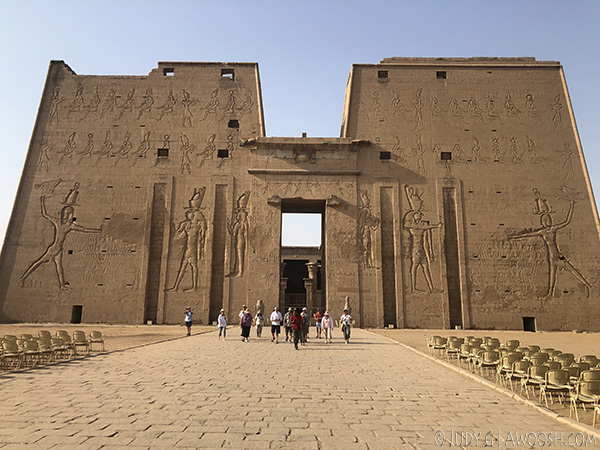
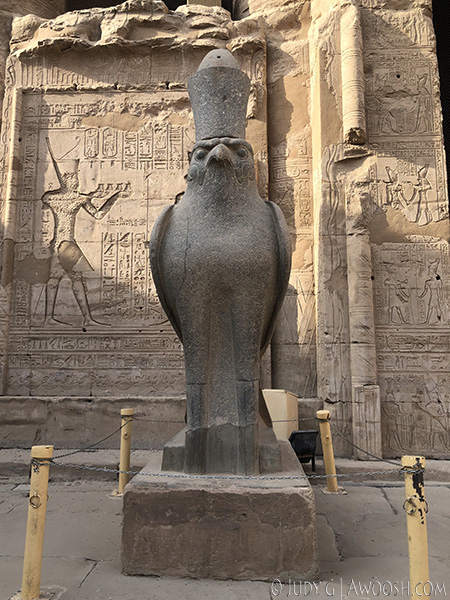
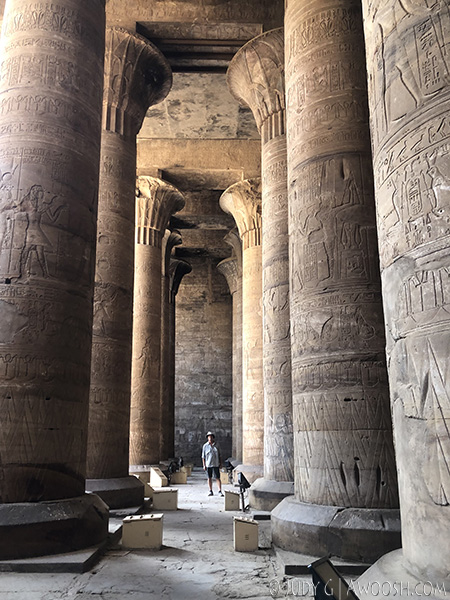
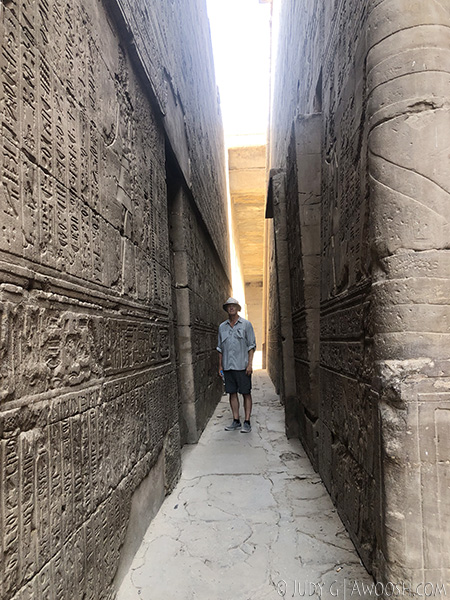
(once they cracked the code via the Rosetta Stone) about beliefs,
historical events, and timelines. Inner and outer walls were formed
to help protect the temple from invaders.
Day 6 — A Day Sailing Up the Nile — Swimming in the Nile — Evening Village Walk
As I mentioned, the Noor El Nil portion of our trip had a lovely rhythm to it – and on our third day aboard, we had a day of leisure to simply enjoy the sights as we sailed south.

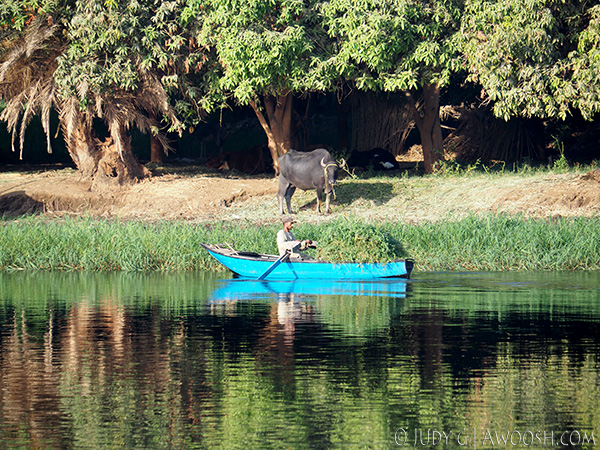
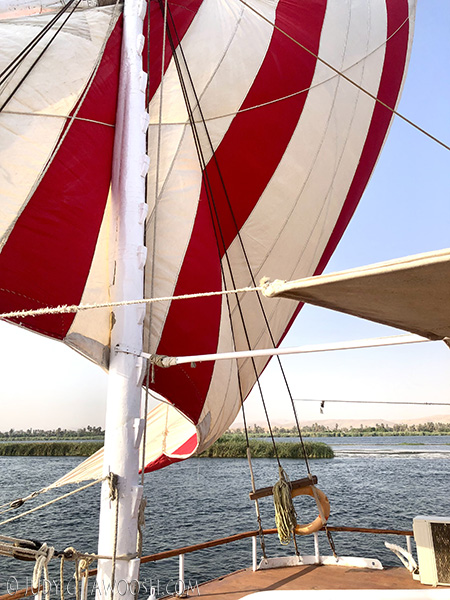

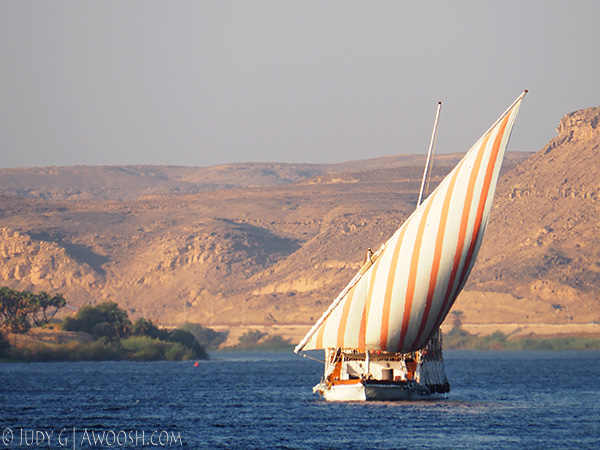
We were offered our first chance of two to swim in the Nile on this day, and almost everyone gave it a go. Swimming in a fairly swiftly moving river is both exhilarating and a little scary. The sudden immersion into relatively cold, deep water and quite a lot of current proved to be more challenging than any of us had anticipated, and almost all of us are experienced divers who are more than comfortable in water. Some caution before leaping in is wise, and with the acuity of hindsight, we should have requested that a couple of the crew be in the water with us, with life rings and/or life jackets ready to hand off to anyone who was having issues with the conditions. A couple of people in our group had some struggles, but fortunately we were all looking out for each other and serious outcomes were avoided.

We are standing on a current-swirling sandbar at the tip of a small islet in the river.
Otherwise, this was a deep water swim.
Photo Cred: Julie C
Later in the afternoon, we were offered a walk into a local rural village. Life is modest in these small towns, but crops appear plentiful.

some of that grass that it is loaded with.
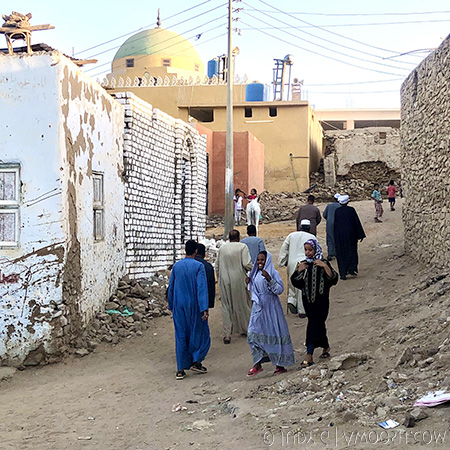
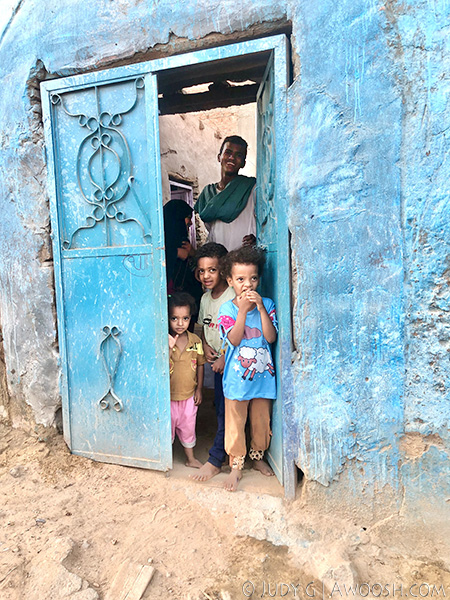

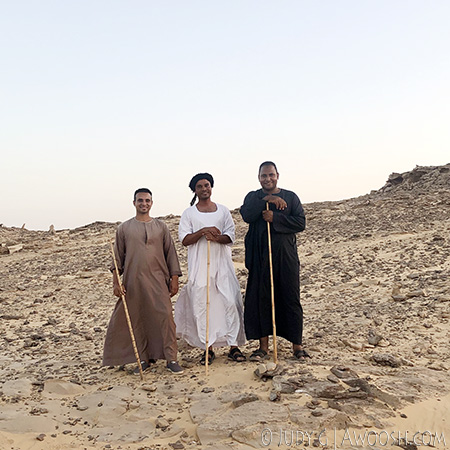
through the desert at sunset, back to the boat.
Day 7 — Gebel Silsileh – Speos of Horemheb – Sandstone Quarries

Another day, another temple, this one quite a bit more modest than some of the huge temples we had been visiting in Egypt. This one was built as a cave, sometime around 1300 BC, for a guy named Horemheb. He’s the king who handed control of Egypt to Rameses I. His tomb is in the Valley of the Kings. This temple has a series of entrances and chambers within, all decorated with images and hieroglyphics describing the king, and the times he reigned in, and like in other temples, some of this was subsequently rubbed out and replaced by embellishments/names of future kings, and eventually Christians, who added some crosses into the mix.

Likely for nobles of the area.

Just beyond the rock temple, as well as across the river, there are huge quarries where sandstone was carved out of the land mass, to be used as columns, architraves, roof slabs and other architectural building blocks, as well as statuary, obelisks and other adornments. From this location, they would have been floated downriver, or sailed upriver, to be installed at various temple sites. This transportation depended on the annual, predictable flooding of the Nile (pre-Aswan Dam), which would allow barges to be floated adjacent to the quarries for loading at high water, and also would allow the barges to be floated up close to the sites where the pieces would be offloaded and installed.
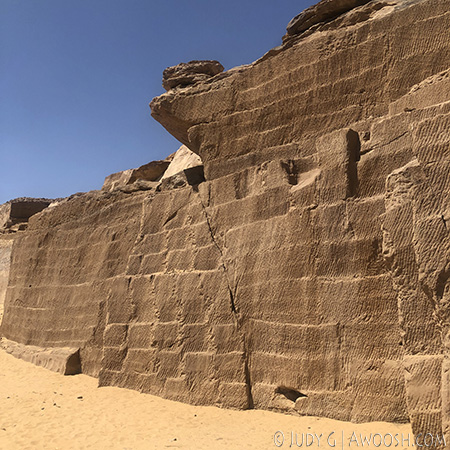

Day 8 — Kom Ombo Temple — Crocodile Museum — Nubian Village Visit — Long drive to Marsa Alam
Our last day on land. A visit was planned for Kom Ombo, near Aswan, another spectacular temple, also of the Greek era in Egypt. More massive pillars, some very ornate carving and decoration, and some fascinating early medical information is inscribed on the walls there as well.
Kom Ombo temple construction started around 180 BC and took close to 150 years to complete. It is actually a double temple – mirrored in a way – with one side dedicated to Horus (the falcon-headed deity) and the other side to Sobek (the crocodile-headed deity). Although not as well preserved as the temple of similar era at Edfu, there is still lots to see here, including some beautiful carvings on the massive sandstone pillars and walls. And the temple’s location, set near the edge of the Nile, makes it a beautiful situation that is fairly easy to access.
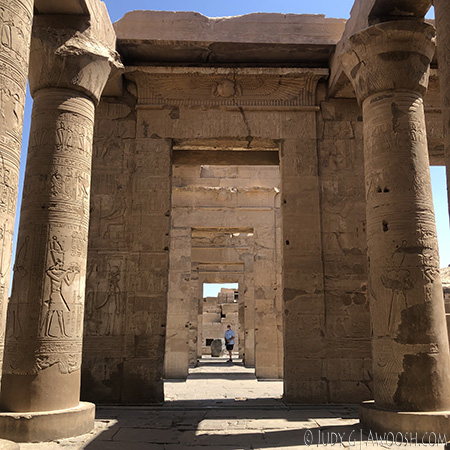
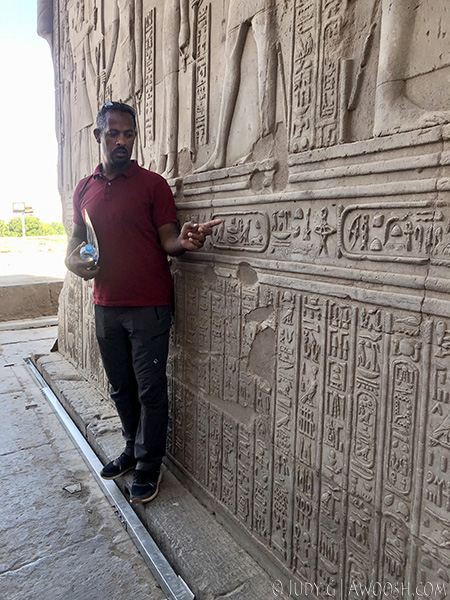

Here a section reveals what they would have looked like, and that they too were carved and painted. In fact historians believe that mineral based paints were widely used in temples, hieroglyphs, and monuments. Areas protected from weather and people in some of these locations show remnants of this coloration.
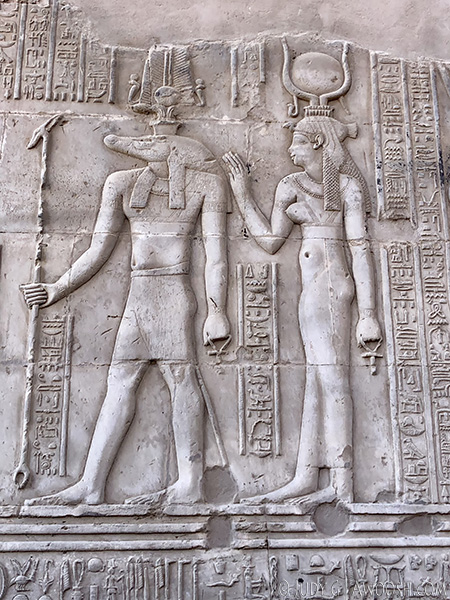
Sobek, crocodile god guy, is on the left.


At the rear of the temple it appeared that the public would come to be treated
by medical practitioners.
Then it was on to the Crocodile Museum, which is nearby. Ancient Egyptians revered crocs, perhaps as a way to appease their (righteous) fear of these beasts. These days, we were told, all the crocs are above the Aswan Dam, and are not seen in the river below it. I still think there is a chance a few errant eggs could find their way over the big dam ;^)
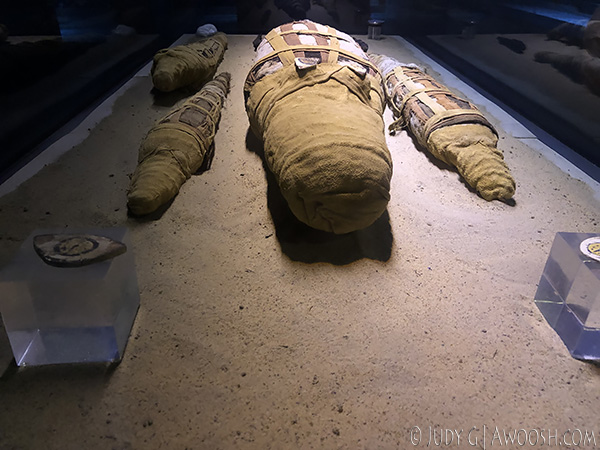
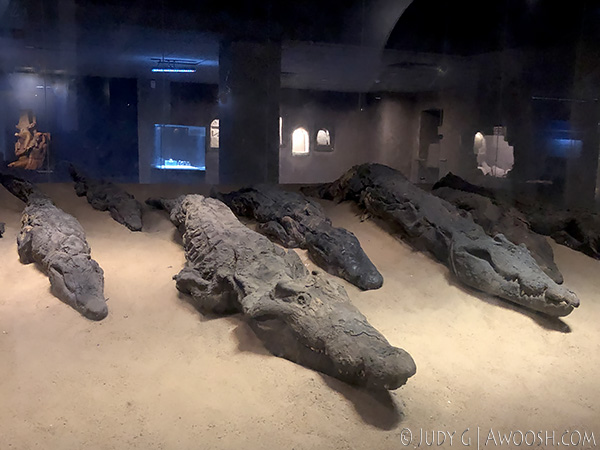
The Egyptians were masters of mummification, and when done right,
human and animal forms could be perfectly preserved for thousands of years.
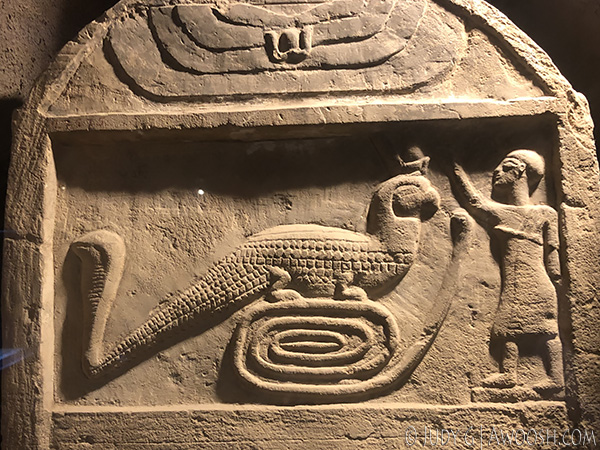
and are depicted often in painting and sculpture.
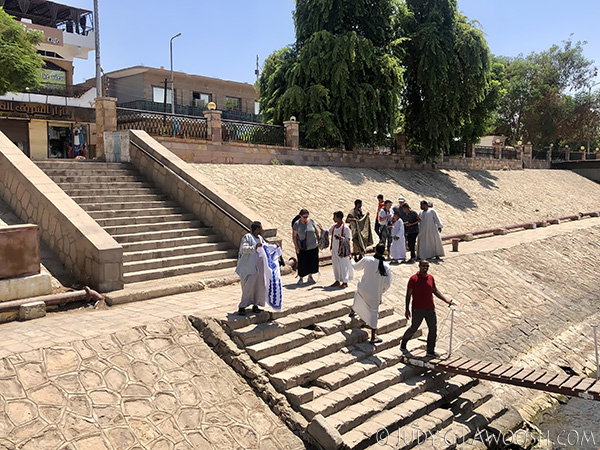
This was the final official stop on the Noor El Nil tour, but our group decided to add on one more activity while we were in Aswan, before we boarded a bus that would take us on a long drive across the desert to Marsa Alam (a port town on the Red Sea), which is where we would climb on a live aboard boat to head out to sea for a week of diving.
Aswan seemed to be a very nice location to visit. I would have liked to have had an extra day or two in the area, so I could have seen the Aswan Dam, and the granite quarry where obelisks were hewn and carved. There’s one still there, partly finished and abandoned, and so it can be seen how the clever ancient egyptians did it.
Our group chose to do a boat trip to visit a Nubian Village, across the river from Aswan. This ended up being a fun excursion, and as an added bonus, we were treated to quite a lot of wild bird sightings along the way.
Nubians, who historically came from the area that is now southern Egypt, and northern Sudan, have been denizens (and at times leaders, at other times foes) of Egypt over the millennia. Culturally they set themselves apart from other Egyptians with their very colourful textiles and ornately painted buildings, and the Nubian village we visited on Elephantine Island was all that. Reading more about it for this trip report, many of the families there were displaced by the building of the Aswan Dam, and the resultant flooding of their homelands by (the huge manmade reservoir) Lake Nasser. So this area was not a traditional homestead for Nubians, but instead a strip of infertile land offered as a compensation. Nubians here have turned to tourism to try to eke an economy out of the desert.
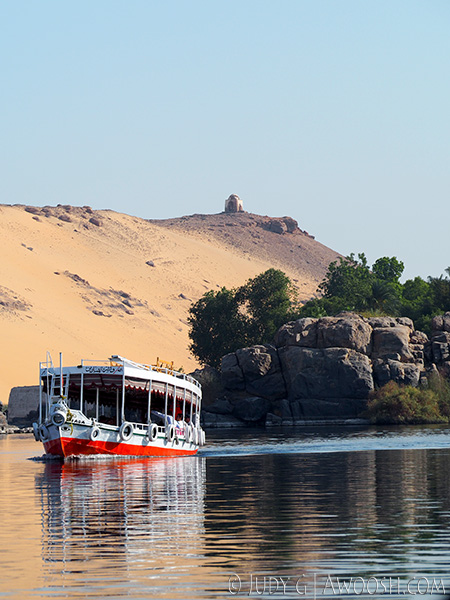
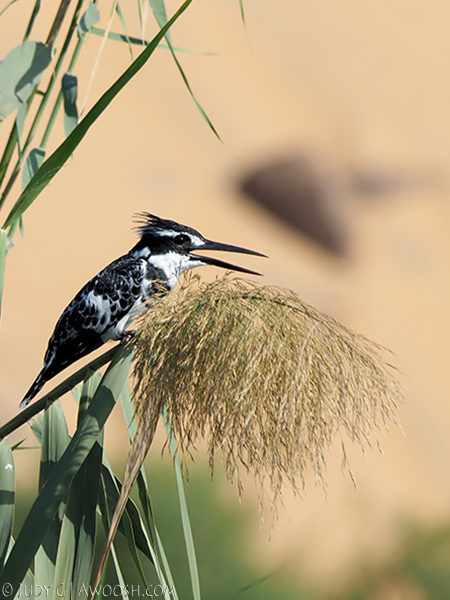
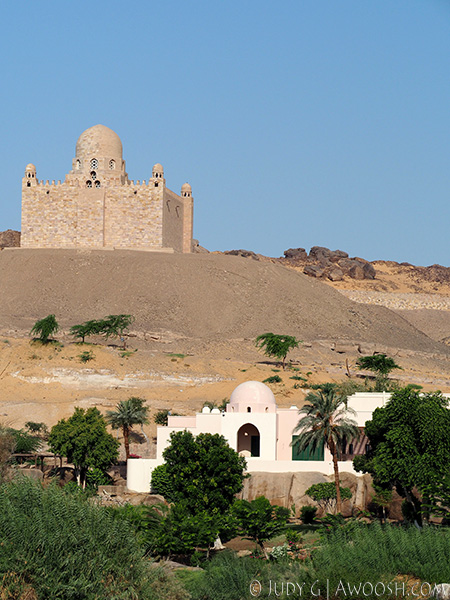
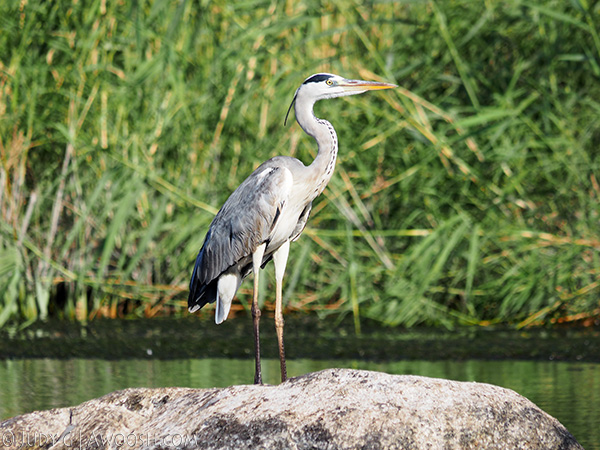


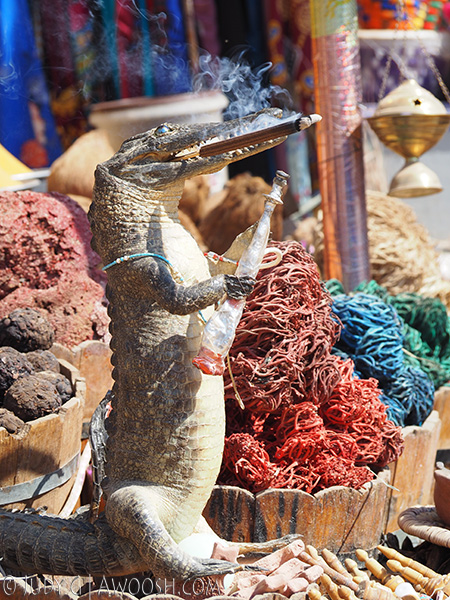


and this a popular destination for them to do that.

black henna tattoos while we visited his home.
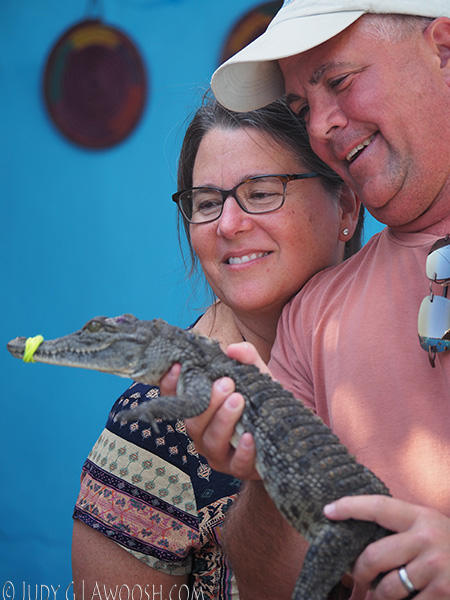
They can bring in some tourist income, but are also revered in Nubian culture.
Then it was a long bumpy bus ride from Aswan to the Red Sea’s Port Ghalib, near the town of Marsa Alam, where we would get on a live aboard for a week, and then head south to dive some beautiful reefs.

Days 9 – 16 – Diving into Egypt’s Red Sea
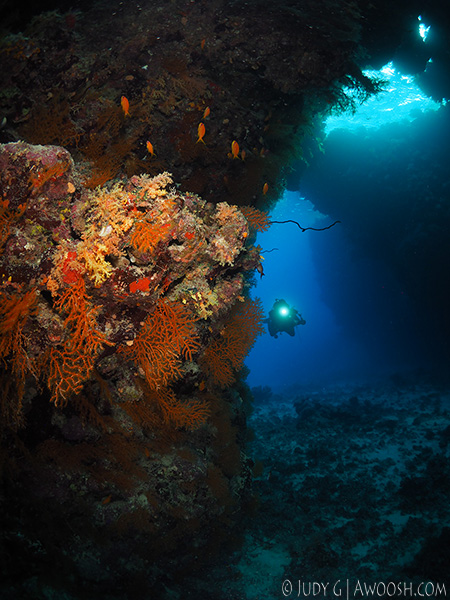
Thumper’s mama once famously said “If you can’t say anything nice, don’t say nothing at all”. So I am going to roll with that advice and not share identifying info about the live aboard that our group chartered to dive in the Red Sea. There were some serious issues that occurred on our trip, mostly to do with apparently faulty parts that were supplied when the crew realized that they needed to add yoke adapters to their tank valves, which were set up for DIN fittings. Most of the people diving the Red Sea are Europeans, and DIN is the preferred system for them. North Americans, other than technical divers, usually dive with a yoke system to attach their regulator to the tank. It was no big surprise that we were incoming – this trip had been planned for several years, so the lack of preparation and the ensuing scramble to get some adapters seemed pretty disorganized and unprofessional.
The result of the problem (which only became obvious after a few days of diving, during which a significant number of our group had O-ring failures, several of them at depth) was a deep distrust in the equipment, and to some degree, the crew, who seemed to initially downplay the situation. We did choose to keep diving, but for sure everyone became super vigilant about the health of their own, and their buddy’s, air supply. I took a lot less pictures than I would have if I wasn’t so tuned in to the very real possibility that my buddy or I could have this problem.
If our group had not been comprised of very experienced divers, any one of these multiple failures could have been catastrophic for someone. You need a calm head underwater when the crap hits the fan like that, and get yourself to the surface safely. It’s very doable; it is panic that kills in these kinds of situations. We were fortunate that the conditions were easy – little to no current, good to excellent underwater visibility, and a couple motorized dinghies were available to pick us up if/when any of us had to surface early, away from the mother boat (from which we did almost every dive), due to a tank fubar.
In the end, the issue was resolved when a few divers in the group offered up some O-rings to try from their save-a-dive kits, which either fit the adapters properly, or were better manufactured than those supplied by the boat. After that, the problem was no more, but the issue for sure affected the enjoyment of the diving on this trip.
O-ring fubars aside, diving in Egypt was nice. The water was very warm (end of summer, apparently it can be much colder at other times of the year). Many of the sites had interesting underwater topography (swim throughs, blue holes, bommies etc, not unlike some of the cool formations we’ve seen on some Cozumel and Fiji reefs). The visibility was good to fantastic. I’d rate the fish life as okay. We did not see any large predators (sharks), but did see a few turtles, some massive moray eels, and on a few occasions, schooling fish. Most sites had healthy coral gardens, some right up to a few feet below the surface. One of our group was a snorkeler, and the crew were able to drop her in on some lovely sites.

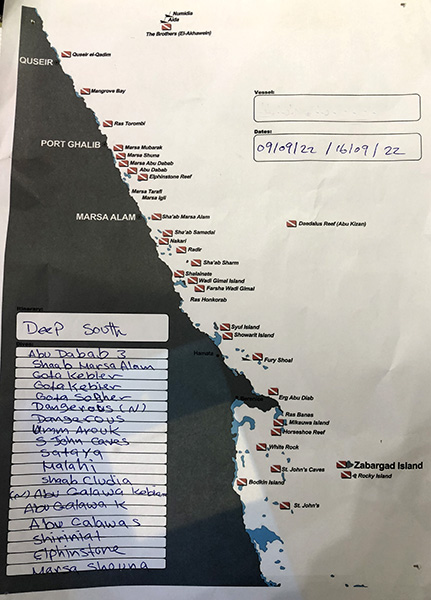
Here is a selection of some photos to give a sense of the flavour of the diving:
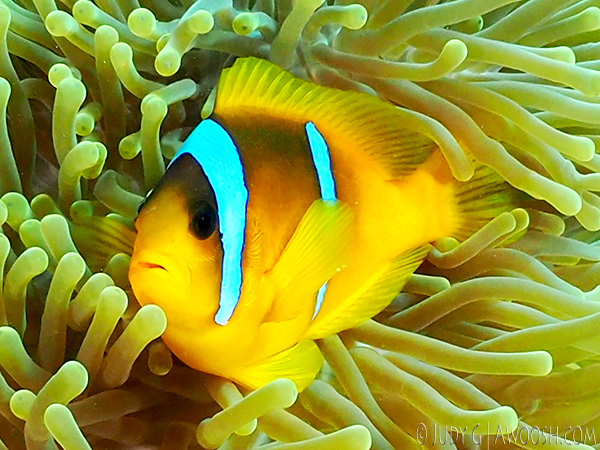
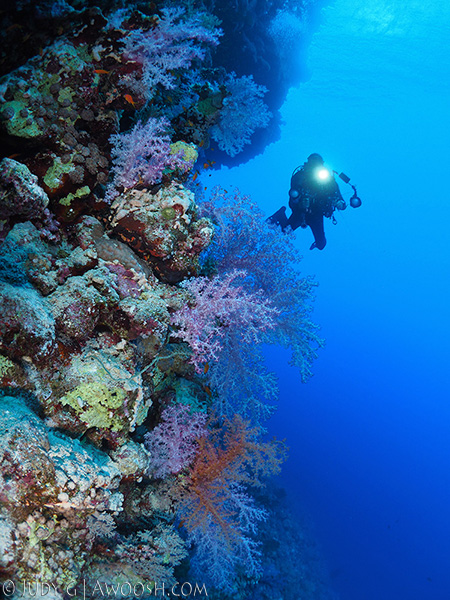
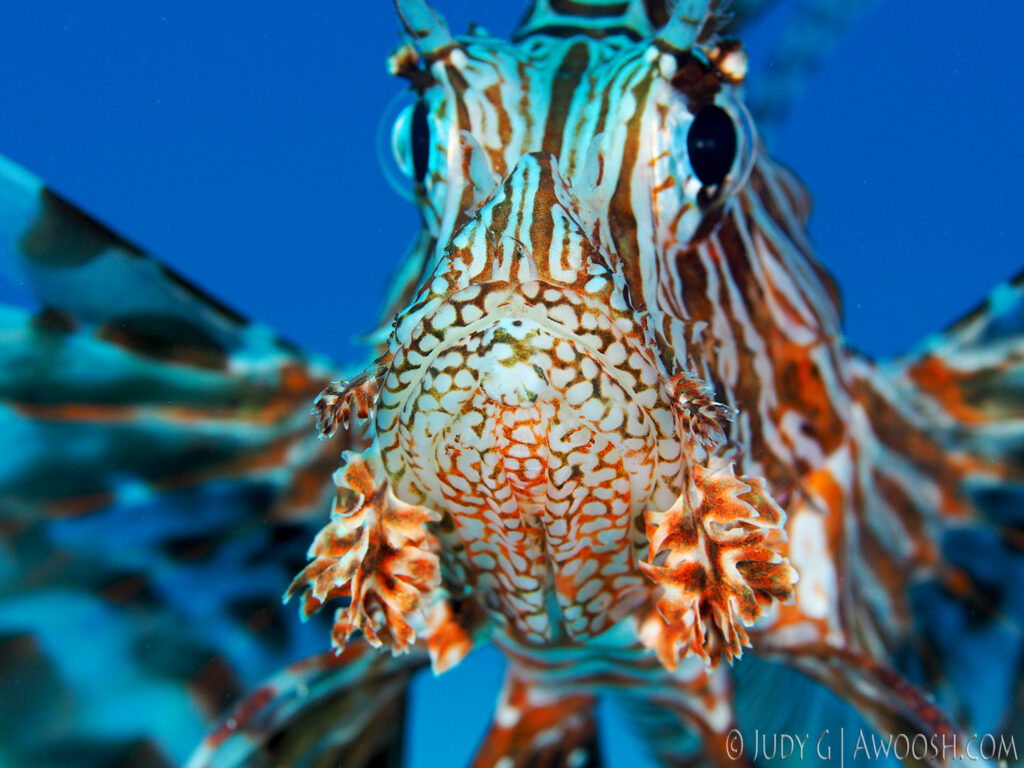
swimming free from the reef out over the sand. These guys pack some serious venom on their fin tips. Must avoid contact at all costs…
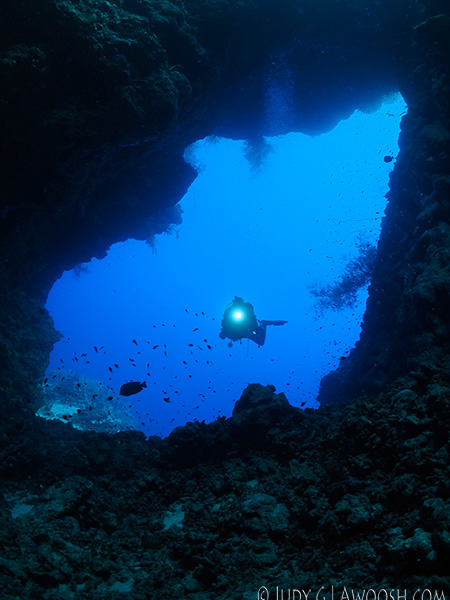


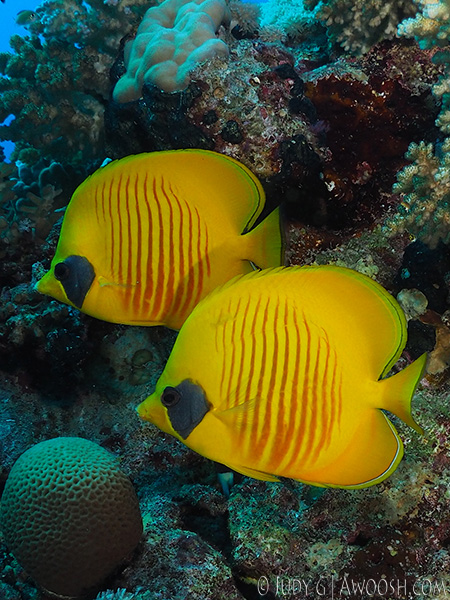
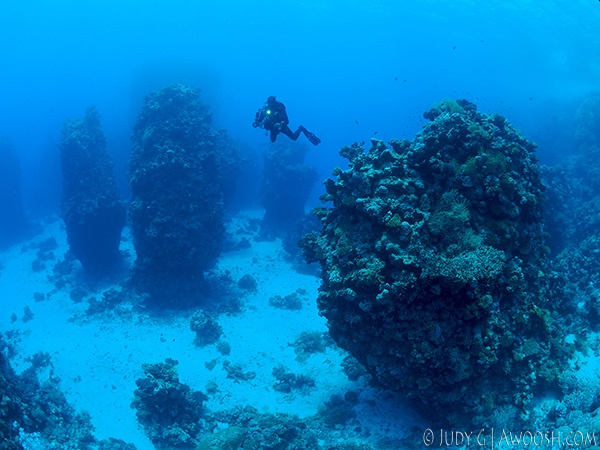
Bommies are pillars of coral that grow up vertically from the sea floor.
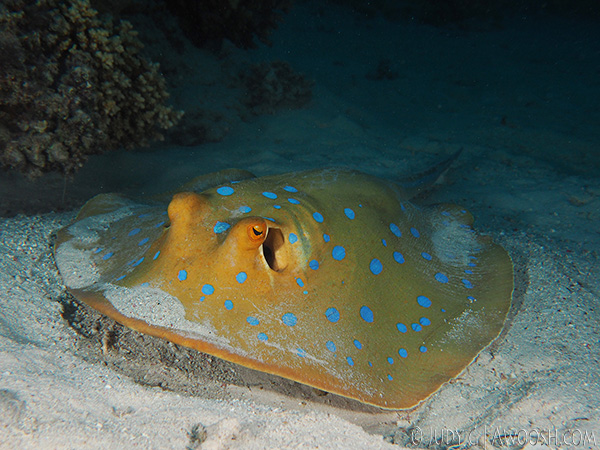
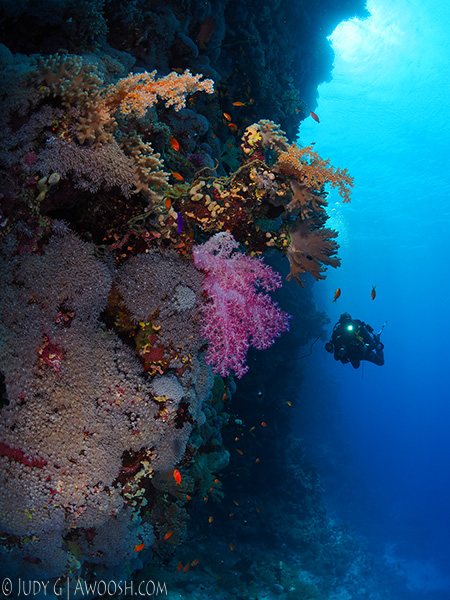
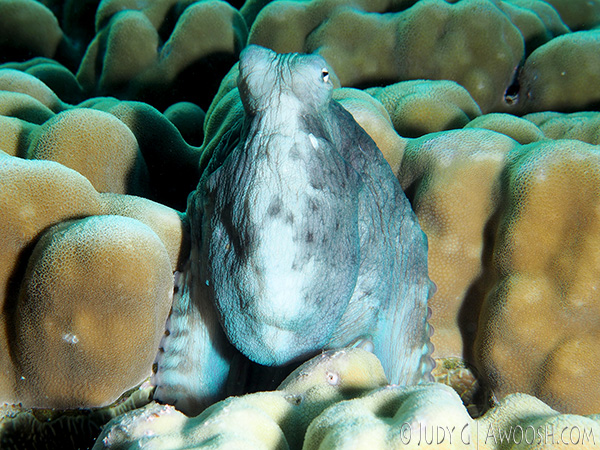
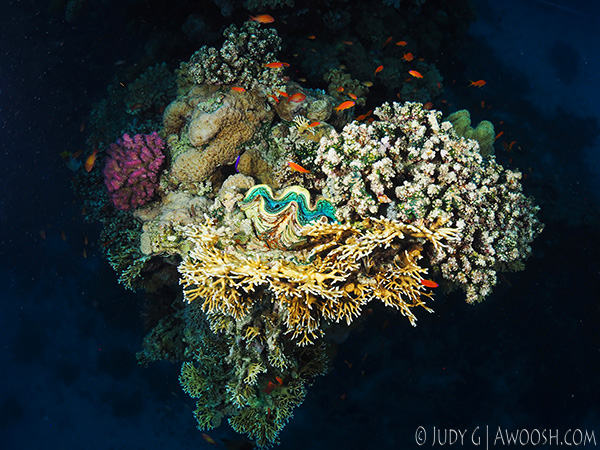
We all anticipated the promised dive(s) at Elphinstone with a mixture of excitement and trepidation. It is a location where Oceanic White Tip sharks are known to frequent – and these are one of the species of sharks that require extra respect. They are quite large and can be aggressive with divers. For a while they closed the site, after too many such incidents – probably related to shark feeding – which creates an unnatural and dangerous link between sharks and humans. We were skunked on the sharks when we got in our one dive there, but once back on board, we looked out and could see one following the dinghy back to the boat! Hard to say whether I was relieved or disappointed ;^)
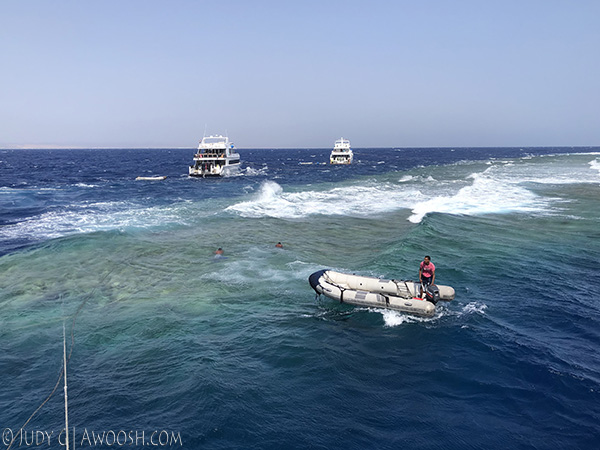
As a result we were only offered one dive instead of two here.
Check out the swimmers on the reef tying/untying the lines!
That’s a serious business, when Oceanic Whitetips are in the ‘hood…
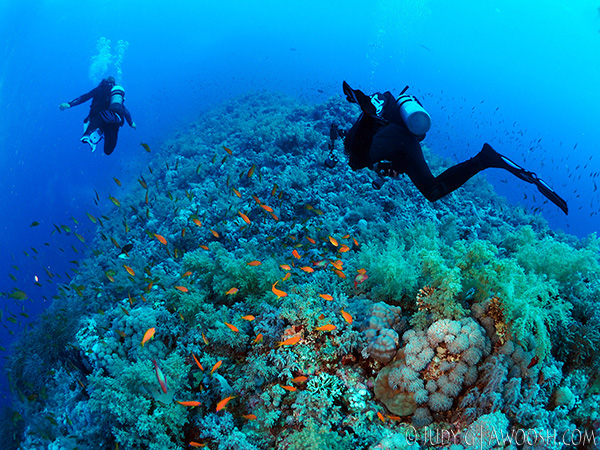

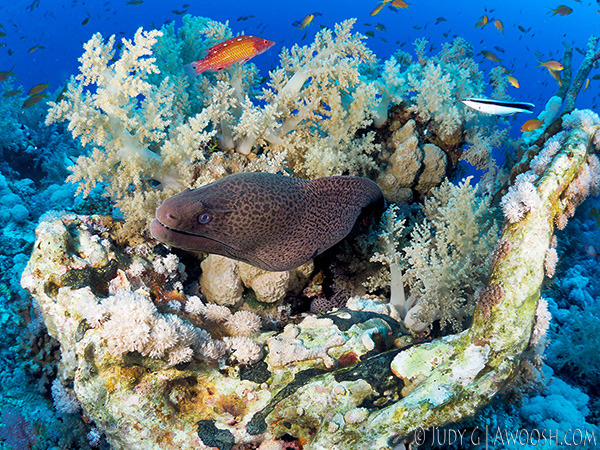
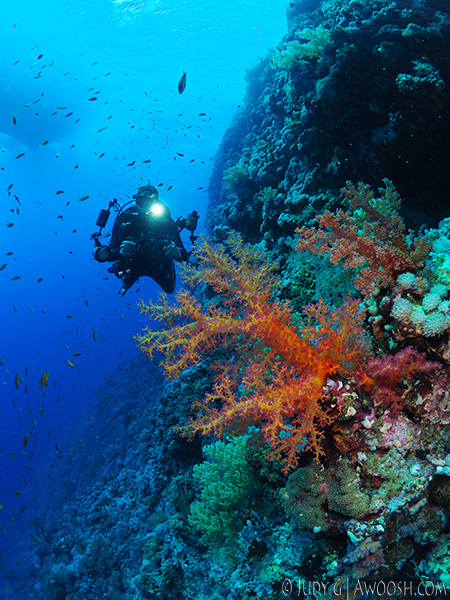

Cue the Jaws music…
A highlight of the trip, for me, was an (unplanned) opportunity to snorkel with wild bottlenose dolphins. It happened between dives, and it was, in a word, Woohoo! I had been hoping for many years to have this kind of encounter. Previously, when I had seen dolphins, they were just flyby critters – a quick looksee and they were gone. In this location, large pods of them stuck around for the duration, thrilling the many snorkelers in the water above them with their antics. In no way captive, it appeared that they thought it was good fun scooting around and below the people bobbing on the surface. There was also quite a bit of nookie happening between some of the dolphins! It was a bummer that my camera was not set up for wide angle (these images were shot with a mid-range lens).


Would I go back to Egypt to dive? Probably not. Not because of the tank fubars, which I think (hope) were just an unlucky situation, but because I think there is better diving that is easier to get to from the west coast of North America, where I live.
There is quite a lot of pressure from many dive boats in Egypt; it’s a wildly popular destination for European divers. Some sites looked to have been damaged by too much diver activity, and at a few locations, ours was just one of many live aboard and day boats diving a site. This was especially true at Elphinstone. Things generally thinned out the further south we went. I didn’t find the biodiversity to be nearly as rich as say, Indonesia and the Philippines, or even Thailand & Fiji, and I didn’t see many varieties of nudibranchs, one of my favourite things to photograph – with their psychedelic patterns & colours, and slow moving enough that I can have my way (photographically speaking ;^) with them. I was happy to get a chance to photograph a few of the endemic species of the Red Sea.
But all in all, Egypt truly was a great adventure – for us, a once in a lifetime kind of trip. What made it the best was sharing it with our most excellent buddies.


2 Responses to Yalla Yalla Habibi!